Please
Note: Firefox and some other
search engines are not suitable – Use “Internet
Explorer” for this page to load perfectly!

Click
the logo above to reach the ssMaritime FrontPage for News Updates &
“Ship of the Month”
With
Reuben Goossens
Maritime
Historian, Cruise‘n’Ship Reviewer & Author
Please
Note: All ssMaritime and other related maritime/cruise sites are 100%
non-commercial and privately owned. Be assured that I am NOT associated with
any shipping or cruise companies or any travel/cruise agencies or any other
organisations! Although the author has been in the passenger shipping industry
since 1960, although is now retired but having completed over 700 Classic Liners and Cargo-Passengers Ships
features I trust these will continue to provide classic ship enthusiasts
the information the are seeking, but above all a great deal of pleasure!
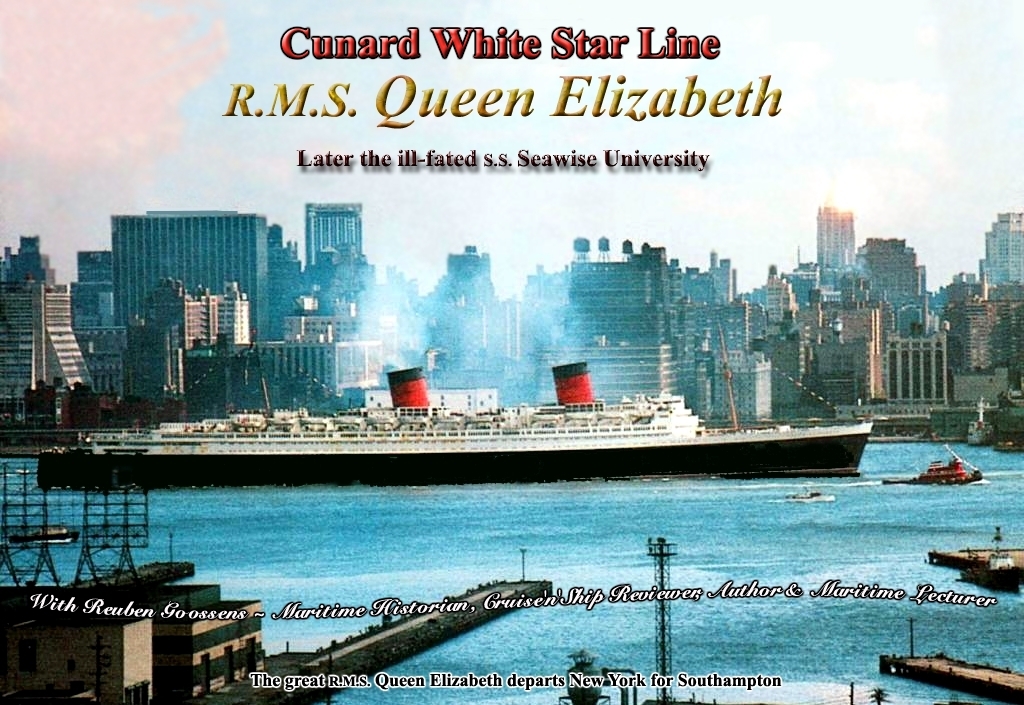
PLEASE
NOTE: Photographs & images on this feature are from
the author’s private collection - Unless stated otherwise.
Page One
Introduction:
Cunard Line White
Star Line had a history of many great and wonderful Atlantic liners in the past
and usually they would operate at least three ships on the service, but when
they commenced planning of what would become the 81,237 GRT RMS Queen Mary in
1928, they were looking towards a two ship operation!
She was laid down on December 27, 1930, but she was not completed until April
15, 1936. The main reason for the delay was that Cunard was in financial
difficulties that were in due course sorted out!
On the very day that the RMS Queen Mary set
sail on her maiden voyage on May 27, 1936, Cunard’s chairman, Sir Percy
Bates, informed his ship designers to commence designing the second ship, but
in order to compete with the ever competing European market, especially the
French liners, such as the magnificent SS Liberty with is grandiose lounges,
that this new Cunard liner had to be larger and more modern than even the Queen
Mary!
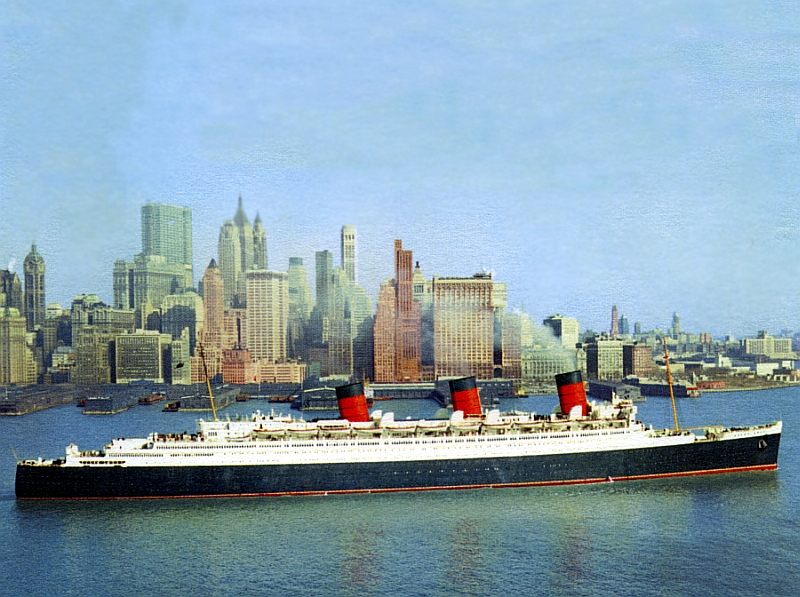
The
great RMS Queen Mary seen departing from New York
***********************************
Hull 552:
But before this
new liner could even become a reality, considering what occurred during the
time the Queen Mary was built, there had to be extended negotiations between
Sir Percy Bates and the Government to formulate a formal contract and
assistance with finance. Thankfully the Treasury agreed to advance £5 million
Pounds to Cunard, and tenders were quickly called out for.
The contract was won, not surprisingly, by John Brown & Co, being the very
same builders of the Queen Mary and her order was officially signed on October
6, 1936. The next big event was just under two months later, being the official
laying of her keel that took place in Yard 552 on December 4, and the building
of hull 552 was underway!
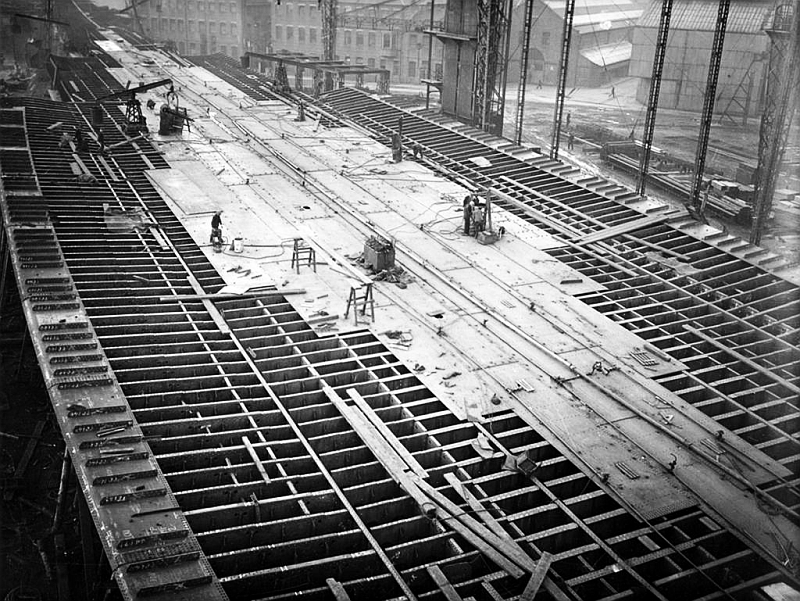
Here
we see her keel laid and her frame well on the way
John
Brown Image
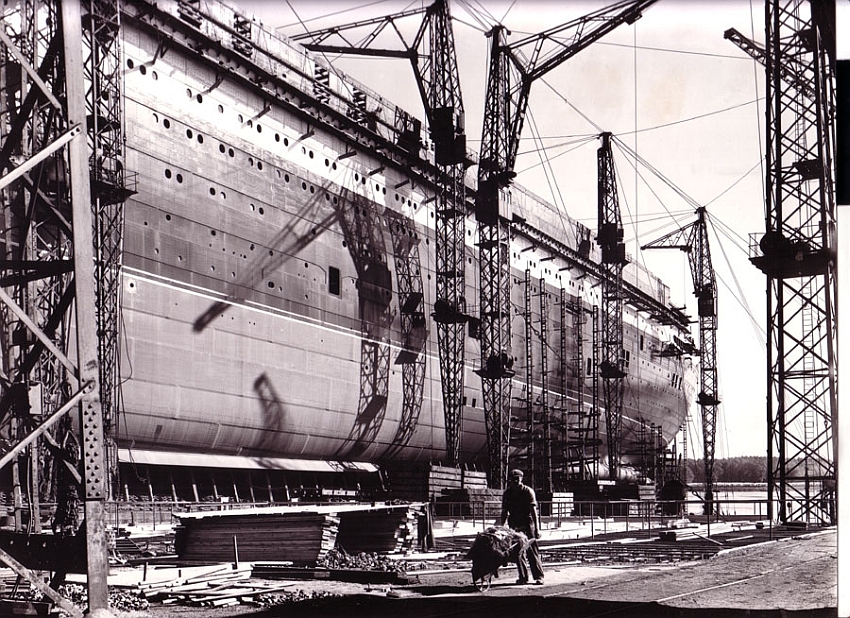
We
see a close up of her completed hull
John
Brown Image
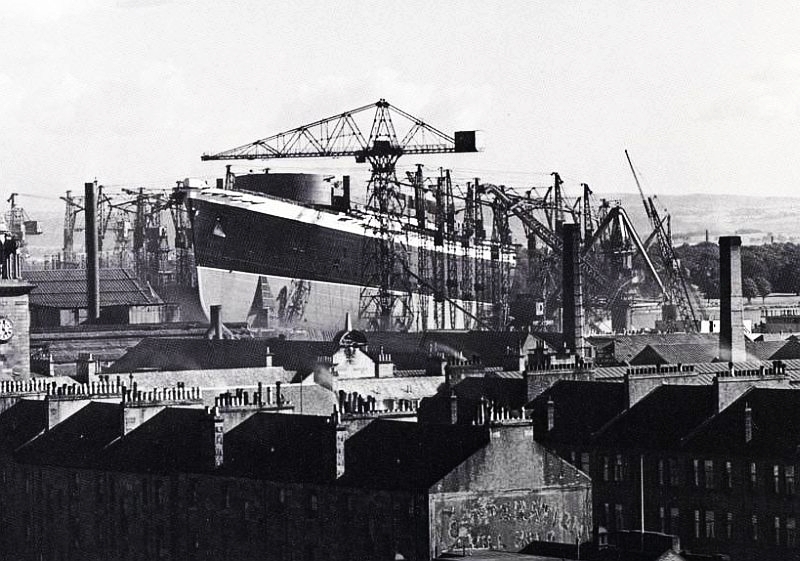
A
fine view of the new ship from a distance showing her grandeur over the local
homes!
John
Brown Image
However, as the building of
this mighty new ship was well underway, it became
obvious that the German Chancellor, Adolf Hitler and his new ideology of a
Third Reich was becoming more and more dangerous. England was by now well aware
of the possibility of a great conflict was about to explode, for there were already
some terrible things happening in Europe as reports had reached London of many
Jews being murdered and later on November 9-10 1938 there was the horrors of Kristallnacht, that saw so many dead and synagogues burned,
full of men, women and children locked inside! Thus the situation certainly
looked like it was becoming a serious threat to the rest of Europe, if not the world. But, building of Hull
552 was at a point where it was ready to be launched.
***********************************
The Launching of a Queen:
HM King George VI was to launch
the ship that was going to be named after his wife, however for some reason, he
was unable to do so, and thus her Majesty Queen Elizabeth arrived at the John
Brown shipyards to launch the new Queen Elizabeth on September 27, 1938.
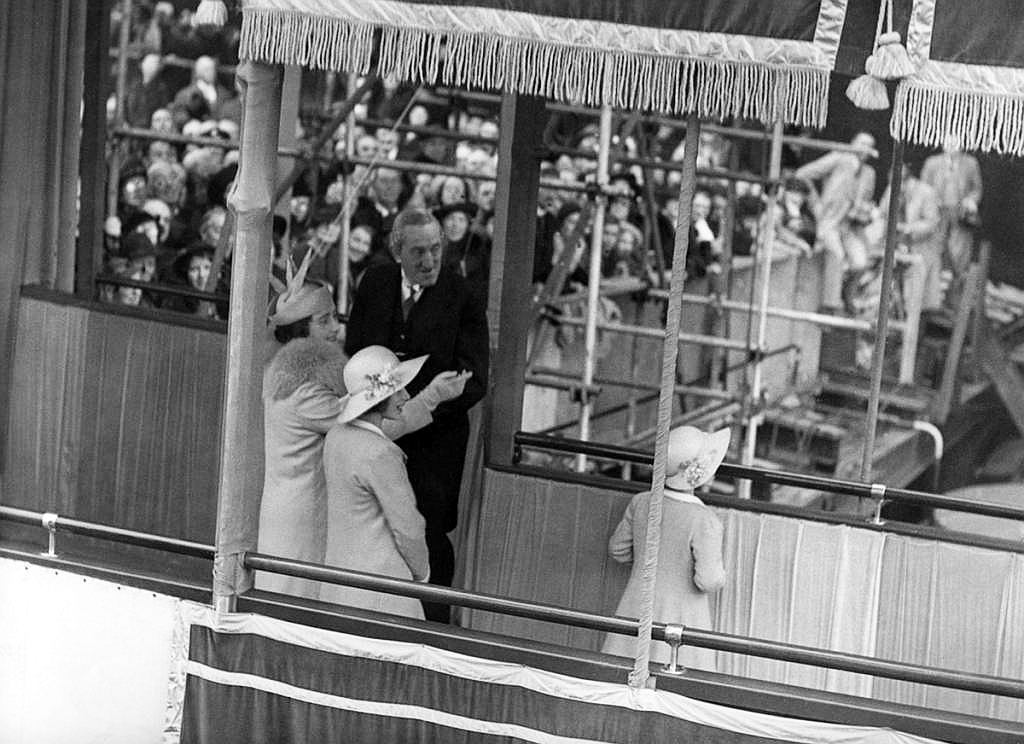
Scenes
on the main podium prior the launching, the two Princesses are notable,
especially Princess Elizabeth,
our future Queen!
John
Brown Image
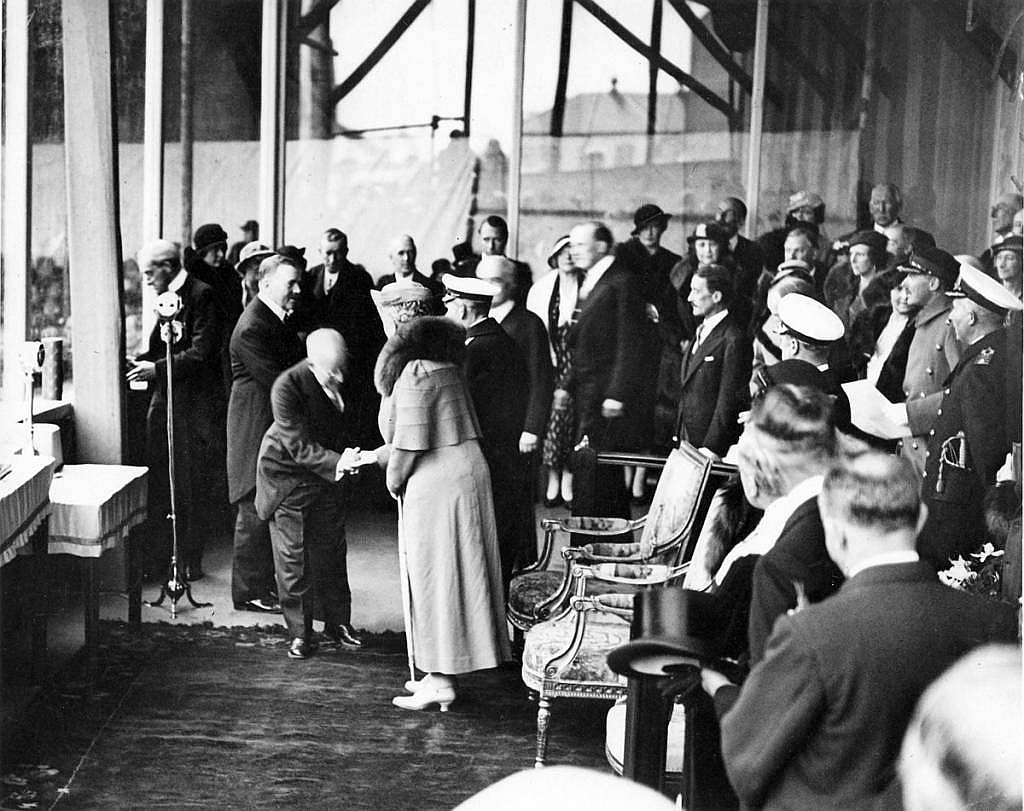
The
queen is greeted by Sir Percy Bates of Cunard
John
Brown Image
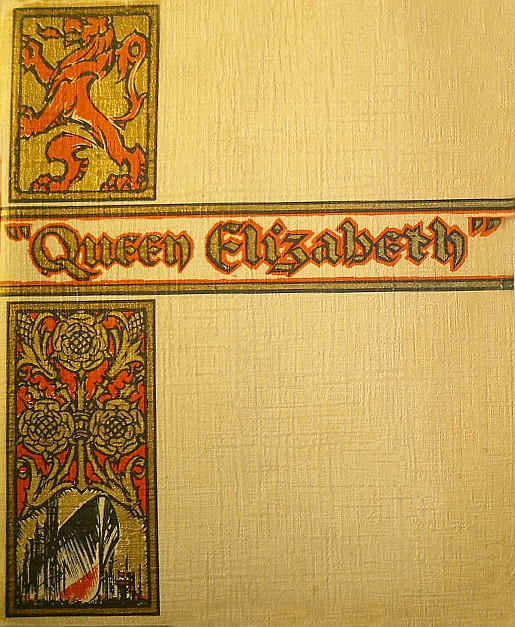
The front cover of
the official launching booklet for the “Queen Elizabeth”
Even though a great war seemed to
be inevitable, but before doing the honours and letting the bottle smash
against the bow and sending the new ship into the water, Her Royal Highness
chose to speak of peace instead of war. She said:
“The King has asked me to assure you of
the deep regret he feels at finding himself compelled, at the last moment, to
cancel his journey to Clydebank
for the launching of the new liner. This ceremony, to which many thousands have
looked forward so eagerly, must now take place under circumstances far
different from those for which they had hoped.
I have, however, a message for you from the
King. He bids the people of this country to be of good cheer in spite of the
dark clouds hanging over them and indeed over the whole world. He knows, too,
that they will place entire confidence in their leaders, who, under God’s
providence, are striving their utmost to find a just
and peaceful solution of the grave problems that confront them.
The very sight of this great ship brings home
to us how very necessary it is for the welfare of man that
the arts of peaceful industry should continue, arts in the promotion of which Scotland
has long held a leading place. The city of Glasgow has been for Scotland
the principle doorway opening upon the world. The narrow waters of the Clyde have
been the cradle of a large part of Britain's mercantile marine, so it is right
that from here should go our foremost achievement in that she is the greatest
ship that plies to and fro across the Atlantic, like a shuttle in a mighty loom
weaving a fabric of friendship and understanding between the people of Britain
and the peoples of the United States.
It is fitting that the noblest vessel ever
built in Britain
and built with the help of her Government and people, should be dedicated to
this service. I am happy to think that our two nations are today more closely
linked than ever before by a common tradition of freedom and a common faith.
While thoughts like these are passing through
our minds we do not forget the men who brought this great ship into being. For
them she must ever be a source of pride and, I am sure, of affection. I
congratulate them warmly on the fruits of their labour. The launch of a ship is
like the inception of all great human enterprises, an act of faith. We cannot
foretell the future, but in preparing for it we must show our trust in a divine
providence and in ourselves. We proclaim our belief that by the grace of God
and by man's patience and goodwill order may yet be brought out of confusion,
and peace out of turmoil. With that hope and prayer in our hearts, we send
forth upon her mission this noble ship.”
After the speech there was a pause, whilst she
was presented with an album of photographs of the ship in seen being built so
far. However, just then the microphone went dead, yet Her Royal Highness took
the pair of gold scissors, the very same one that HRH Queen Mary had used to
perform the naming ceremony of her namesake the Queen Mary, and she cut the
red, white and blue ribbon and sent the bottle of Empire wine crashing to break
just in time against the liners already moving bow. With great presence of mind
she said with a strong voice, “I name this ship Queen Elizabeth and wish
success to her and all who sail in her,” as the ship continued her way
into the Clyde!
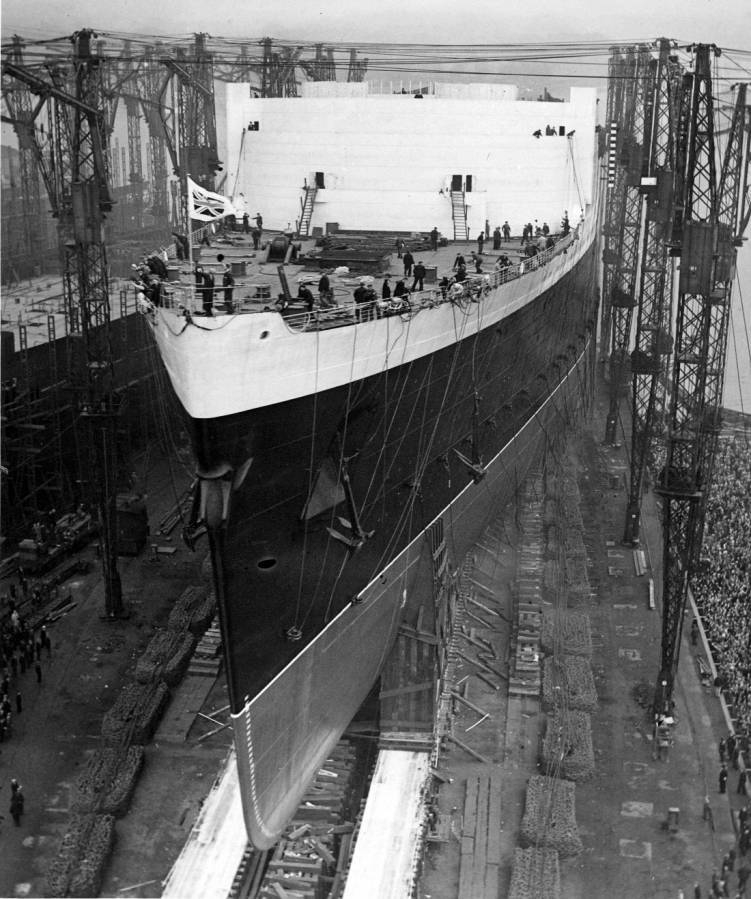
The
Queen slips down the slipway
John
Brown Image
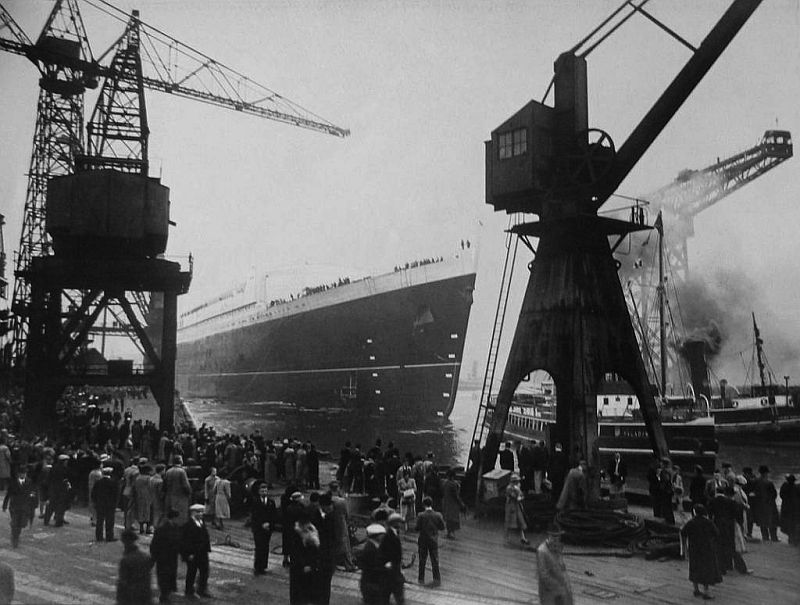
Finally
she is finally in the water and ready to be completed
John
Brown Image
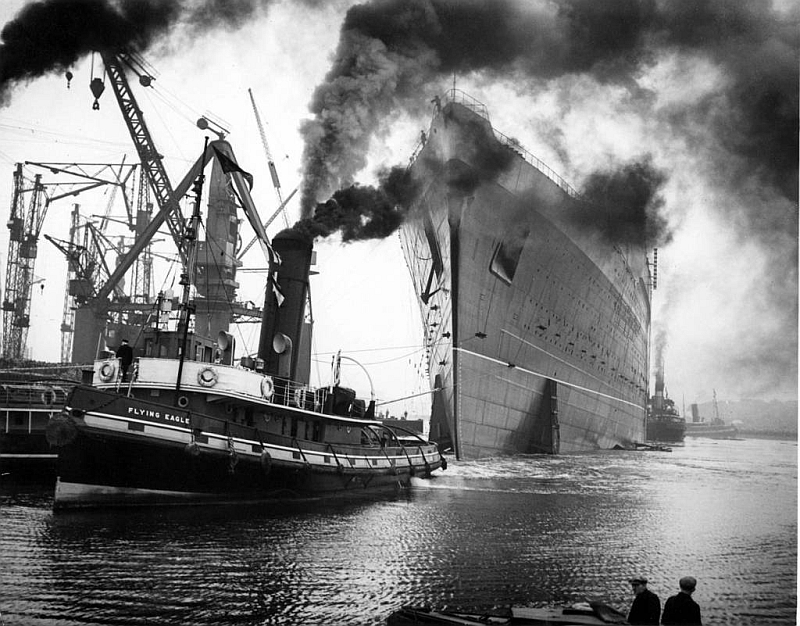
The
tug Flying Eagle and other tugs tow the giant Queen to her fit-out berth
John
Brown Image
There was no
doubt, but the launch was a great success, and as the now officially named
Queen Elizabeth was in the water, she was towed to her fit-out berth on the
River Clyde. But work had to be suspended frequently, due to the oncoming war
as many of the nation's Navy and other ships now required refurbishments for
active duties.
Please Note: On
this page you will discover many photographs of her exteriors in her various
guises, be they pre war, as a troop ship and as a liner, as well after her aft
decks were extended, etc. However, on Page Two you will find all he interior
images, as well as a few other photographs. The link to that page is located at
the bottom of this page, and when you have read fascinating history then you
will want to see what she looked like, first in her early days, and then after
her later refits. Enjoy!
***********************************
World War Two:
On September 1,
1939, was officially day one of World War Two, for Hitler marched into Poland, and thus he made
enemies of Britain
and all her allies. As the discord grew, sadly the Queen Elizabeth remained
unfinished and Cunard waited for a decision to be made about workers to
complete her. On
September 16, 1939 the ship was paid a secret visit by HM King George VI and
Queen Elizabeth at her fitting out berth in Glasgow.
But some action needed to be taken for she
could be of great use during the war and she could be converted into a
troopship. However, this work could not be done in the Britain
mostly due to the possible threat of German bombers as well as, who knows,
saboteurs? Obviously being the grand liner she had been promoted previously as
the largest that was to be built, the Queen Elizabeth would a target for German
Luftwaffe, for if any of their pilots could drop a bomb on this huge ship and
sink her would have a double effect, one it would be a massive hit against the
British, but secondly, it would give great pride to the Nazi and they would
commence a huge propaganda campaign! But, England
had other plans in hand! With her engines already
installed, on February 26, 1940 the almost completed liner left her berth under
her own power and she sailed from the Clyde
to an anchorage just off Gourock.
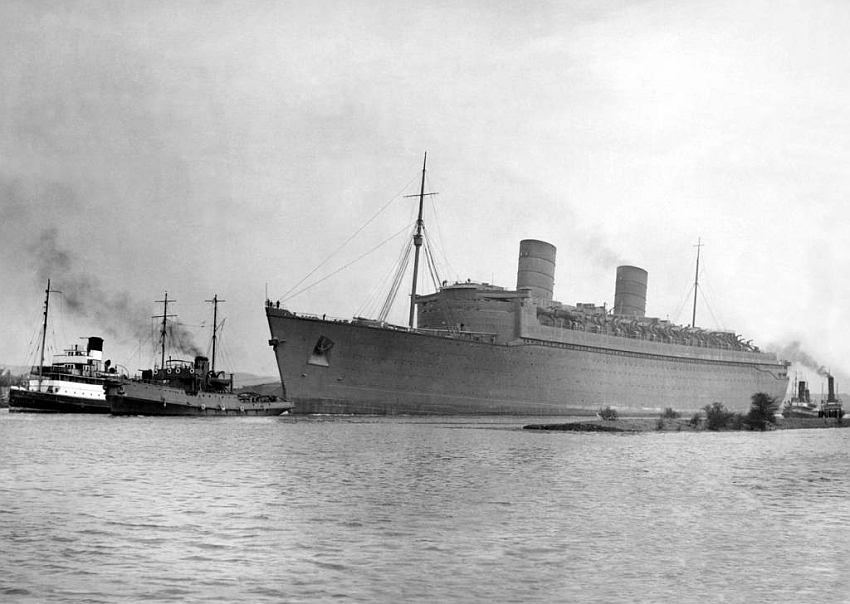
The
Queen Elizabeth leaves the Clyde
for her anchorage off Gourock
Then on March 3,
1940 she left her anchorage without notice and sailed out to sea. To confuse
agents and spies, the story had been circulated that this was Queen
Elizabeth’s positioning voyage to Southampton, but the truth is that only
the very few ashore in the hierarchy of the Admiralty knew of her true
destination, but not even the captain on the Queen Elizabeth knew anything as
well!
***********************************
The Great Escape:
Only once she was
out at sea out at sea, Captain John Townley was
allowed to open his safe and he took out the sealed orders, which told him to
head directly at full speed for New York, which he did with a crew of just 400
personnel on board. Not surprisingly, later that day, a squadron of Nazi
bombers were spotted over the Solent, where the Queen Elizabeth would have been
berthing at that time, had she been heading for Southampton, thus the deception had worked
rather well.
What could be called her first maiden voyage
of sorts, but amazingly she did not even had her
official deep sea speed trials as yet, but her voyage did prove that her
engines were working beautifully! The rather dull looking Queen Elizabeth,
considering she had been painted in wartime grey, arrived in New York
harbour on March 7, 1940.
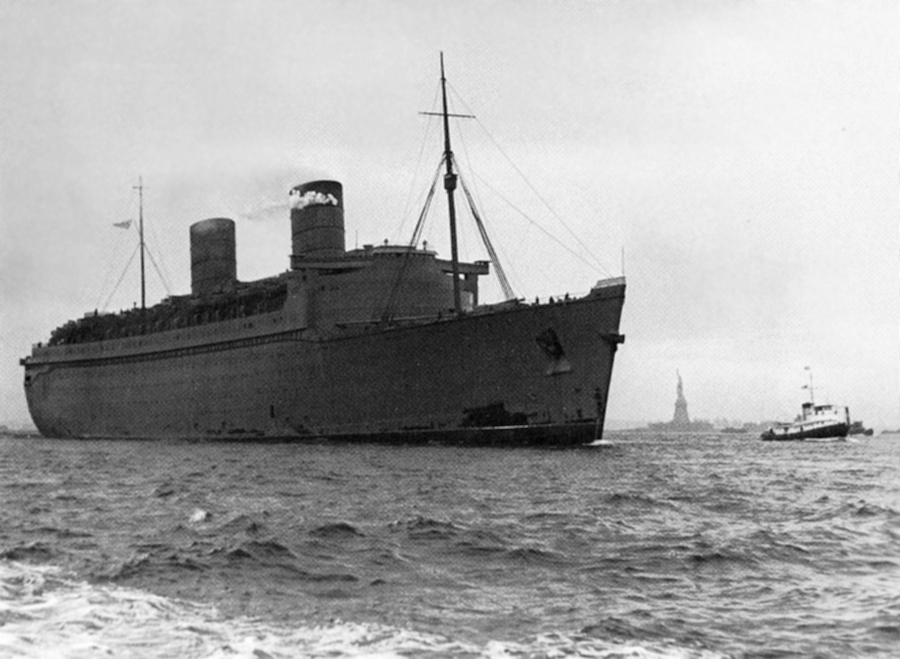
Queen
Elizabeth passes the Statue of Liberty at New York
on March 7
A
Coast Guard cutter escorts the Queen in the Hudson
and to her berth
As no one was
expecting her, with this being very much a secret voyage, she caused quite a
surprise some excitement amongst the maritime community and ship lovers! Many
lover her modern look, such as the ship not having a well deck, and her cleaner
cut bridge that that of the Queen Mary, then there were those two majestic
large funnels, rather than three. It all meant a new and a more refined package
to the American Maritime community, even though she was in her rather dull
looking livery!
Amazingly, during March of 1940 there were
four of the world's finest liners, such as the Mauretania, Normandie, Queen
Elizabeth and Queen Mary, were all berthed alongside each other, including
three of the world’s largest Ocean Liners!
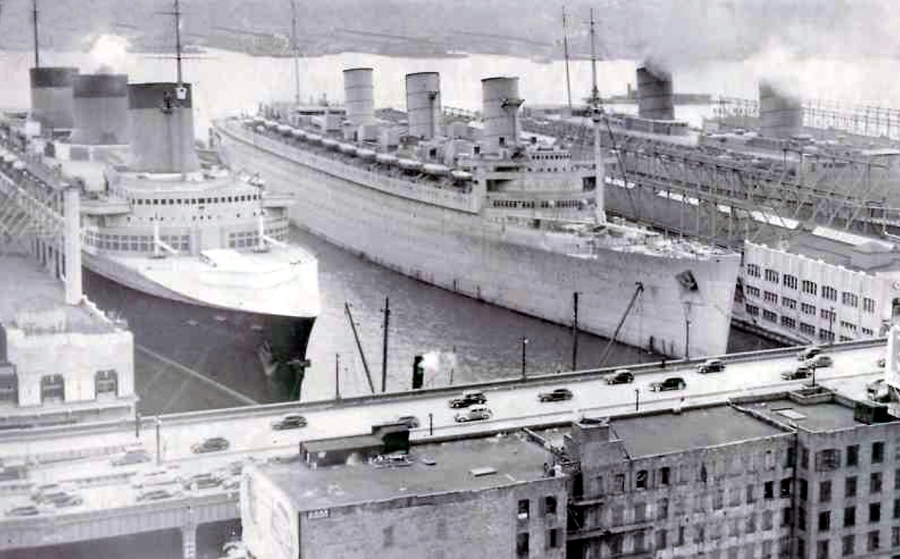
New York
March 1940, L to R: SS Normandie, RMS Queen Mary and
Queen Elizabeth
On March 21, the
Queen Mary departed New York
as she was bound for Sydney, Australia,
where she would be transformed into a full scale troop
ship, capable of accommodating up to 5,000 soldiers. She became known in Australia
and by others as the “Grey Ghost!”
However, Queen Elizabeth remained in New York
and for a considerable length of time as she needed to have some further work
to be carried out whilst there, such as additional electric wiring and light
fittings. In addition they still had to remove her launch gear that was still
attached to her hull and some other work needed.
The Queen Elizabeth departed New York on November 13, 1940 and sailed for Singapore, via Cape Town.
There she received the first part of her refit into becoming a troop ship that
was done in graving dock at Singapore.
Suitable defensive armament was fitted, such as anti aircraft guns, etc.
Internally it was fitted out to carry troops as it had now been requisitioned
by the Ministry of War Transport.
***********************************
Queen Elizabeth the Trooper:
On February 11,
1941 she departed Singapore
for Sydney, where she
arrived on February 21. Once the fitting out into a troop ship was completed,
she the Queen Elizabeth joined the Queen Mary, and made her first voyage
transporting Australian troops to the Middle East and spent the next five
months carrying troops from Sydney
to Suez, whilst returning
with German POW's. After the US entered the war and
sailed to Esquimalt in Canada, and carried troops
to Sydney.
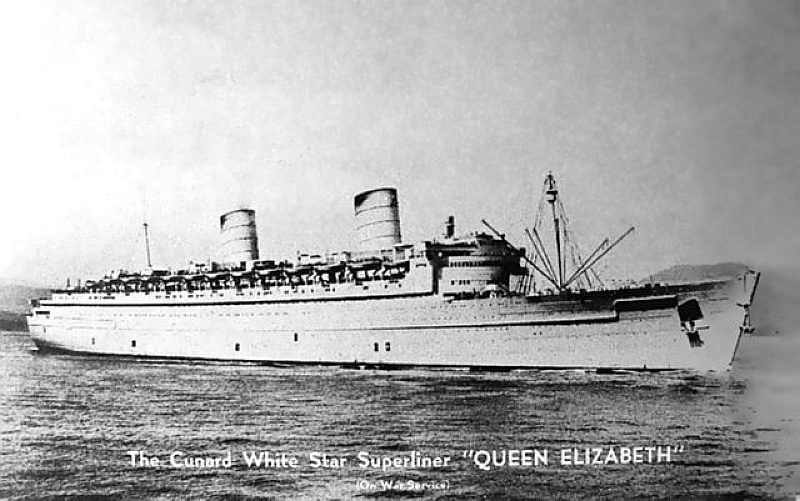
Postcard
of the Queen Elizabeth after having been fully fitted out as a troop ship and
is now in service
However, one major
problem was that sailing in this region was very much warmer, if not very hot
at times, than what these ships were actually constructed for.
They had no air-conditioning and worse still there was hardly any ventilation
inside, for that was just not needed on the Atlantic! Thus, the so-called luxury Queens
were far from being comfortable, and they did not provide the soldiers a great
way to be shipped, for these were extreme and harsh conditions! All too
frequently fights would brake out among the troops and they could get very
rough, for the men were sick of the hot and harsh conditions, yet they had no
idea what awaited them, which would be much worse, for sadly
most would not come home, and we could not provide them with a decent
cool bed there?
But thankfully the Admiralty saw some reason
at last, and by the end of 1941, for finally something occurred that would put
both the Queen’s back on the North Atlantic and that is where they should
have been all the time!
Unbelievably, there were even some plans in
1942 by the Admiralty who had plans drawn up to convert both the Queens into
aircraft carriers, but thankfully this stupid idea was later abandoned, and
that was only because it was considered that their current role as troopers was
simply far too important as they were able to move huge numbers per ship!
It was in April 1942 that the Queen Elizabeth
was relocated from Sydney
to New York. It was
there where the troop accommodation was altered to make its capacity to a
mammoth 10,000 soldiers. In June 1942 it began to make voyages from New York to Gourock
Scotland
and then to Suez,
sailing via Cape Town.
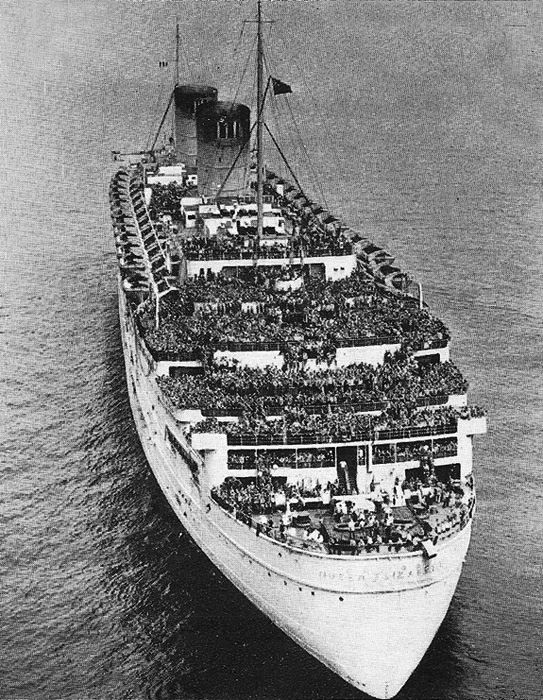
A
fine aerial view of her stern and the over crowding is rather obvious!
In August it began
a shuttle service between New York
to Gourock and that is regardless the relentless
threat of U-boats, but somehow the great Queen somehow continued her service
and remained untouched. However, there was a loose report in the German press
at one stage that the English liner Queen Elizabeth had been hit by a torpedo
from one of their U-boats.
***********************************
Peacetime:
With World War Two
having finally concluded the Queen Mary was retained in her trooping service,
keeping her and all grey livery except that her funnels were once again
repainted in Cunard’s regular Red and black top colour’s. In fact
she continued in this role for one further year as she did transported returning
troops and G.I. brides to the United States,
etc.
Apparently by the end of the war in Europe,
the two Queens
had transported around one million troops to the fighting zones and one wonders
how many of them came back? But of course, now came the next job, and that was
to repatriate the troops and redeploy them for the war against Japan.
The transporting of American troops continued until October 1945 when the Queen
Elizabeth was officially released from US
service and re allocated to the repatriation of Canadian troops.
However on March 6, 1946 she returned to
Southampton and the world’s largest passenger liners was released from
Government duties as the need for troop movements had diminished. During the
war she had carried transported just 750,000 troops and sailed a 500,000 miles
or 804.672 kilometres.
This great ship had never seen a single day
being the great passenger liner since the day of completion, and now she
required a massive overhaul and refit to make her the ship Cunard had intended
her to be an Atlantic luxury liner!
This work would be carried out on the Clyde and also at Southampton.
On March 9, 1946, before she departed for the Clyde, there was a fire on the promenade
deck, but as it was spotted quickly, it was extinguished rapidly, yet it still
caused considerable damage to the area. It was always thought that the fire was
arson, but there was never any proof.
At the end of March Queen Elizabeth departed
Southampton for the “Firth of Clyde Dry-dock” in Greenock by the John Brown Shipyards. There
she was repainted in the traditional Cunard livery and her machinery was
completely overhauled. By June 17 she returned to Southampton for her extensive interior
refurbishments.
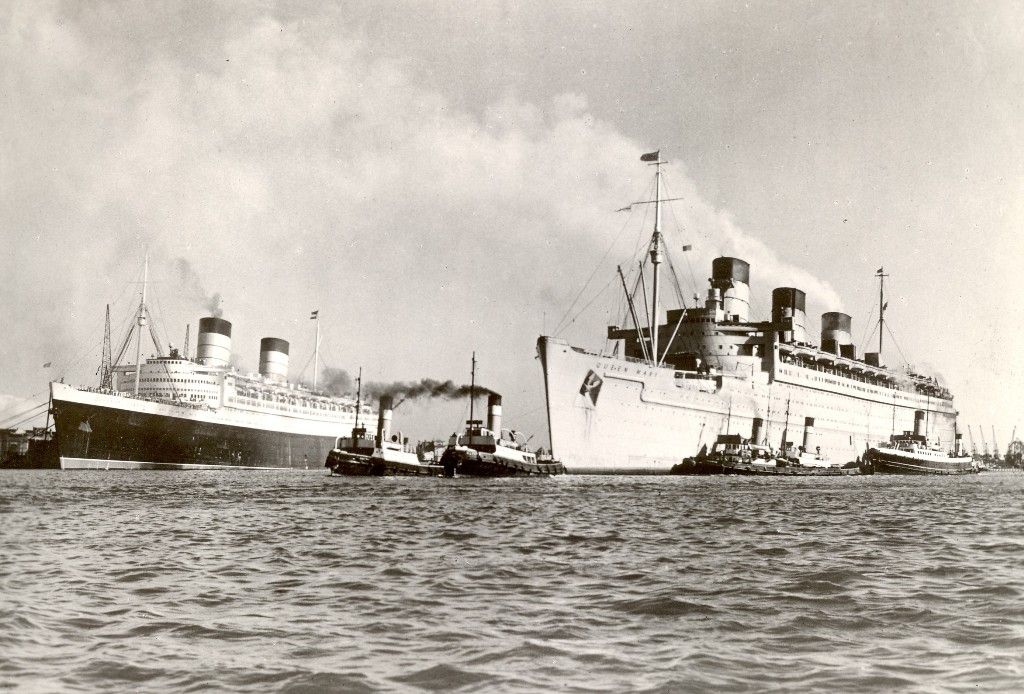
This
was taken just before Queen Elizabeth’s sea trails, having been completed
and fully repainted in Cunard livery
Whilst
we see The Queen Mary still in hew war colours as she was just concluding her
war duties on this day
This
very special photograph was taken on September 27, 1947, and a souvenir
postcard was made from it
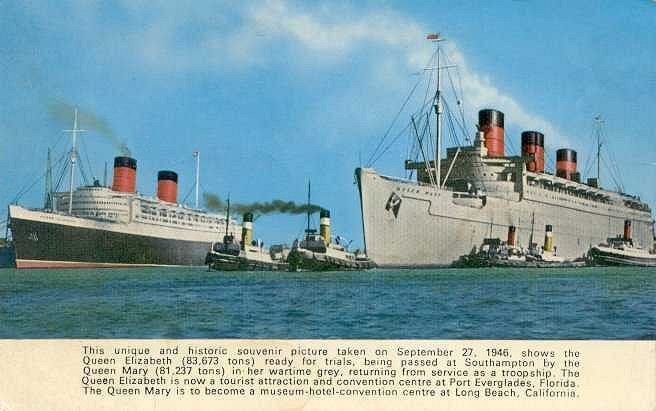
Considering
the great Queen had been for six years of heavy war service, yet, there had
never been time to take her on an official measured speed trial, but now with
the work fully completed at the Clyde by John Brown and interiors at
Southampton, this was the opportunity to do so, and she departed under the
command of Commodore Sir James Bisset and she sailed
to the Isle of Arran and her trials were finally carried out.
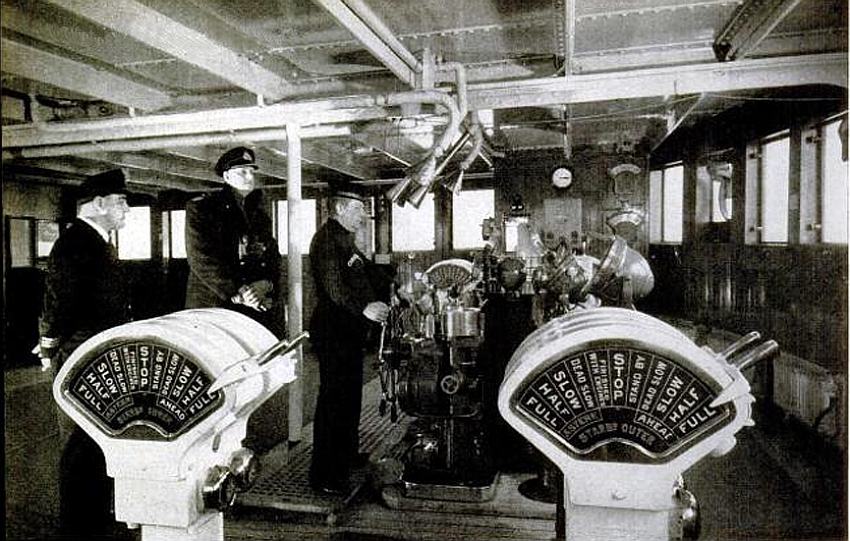
Here we see her grand
Bridge with her Captain in command!
I have no date for
this image
However, for her trails the ship
was greatly honoured, for onboard was the ship's namesake, no less than HRH
Queen Elizabeth herself, as well as her two daughters,
Princess Elizabeth and Margaret. During the voyage her Majesty Queen Elizabeth
even took the wheel for a short time, whilst the two Princesses recorded the
two measured runs with their stopwatches that they had been given especially
for the occasion. Commodore Sir James Bisset was
under strict instructions from Sir Percy Bates that the only thing that was
required from the trails was two measured runs of no more than thirty
knots and that she was not permitted to attempt to sail a higher speed
than that of the Queen Mary, even though the Queen Elizabeth was capable of
doing a greater speed, in fact around 32 knots or more! The trails concluded at
Southampton.
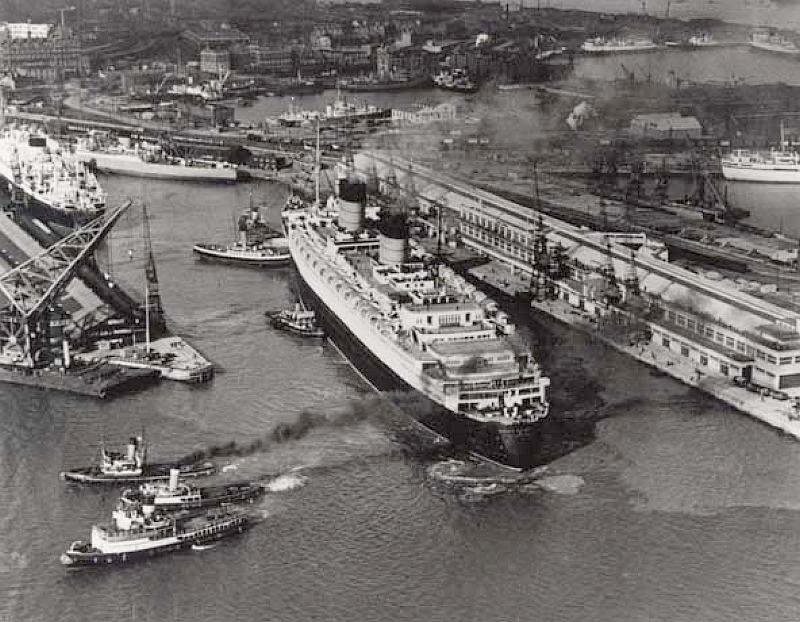
At
the conclusion of her trails she returned to Southampton to be made ready for her maiden
voyage
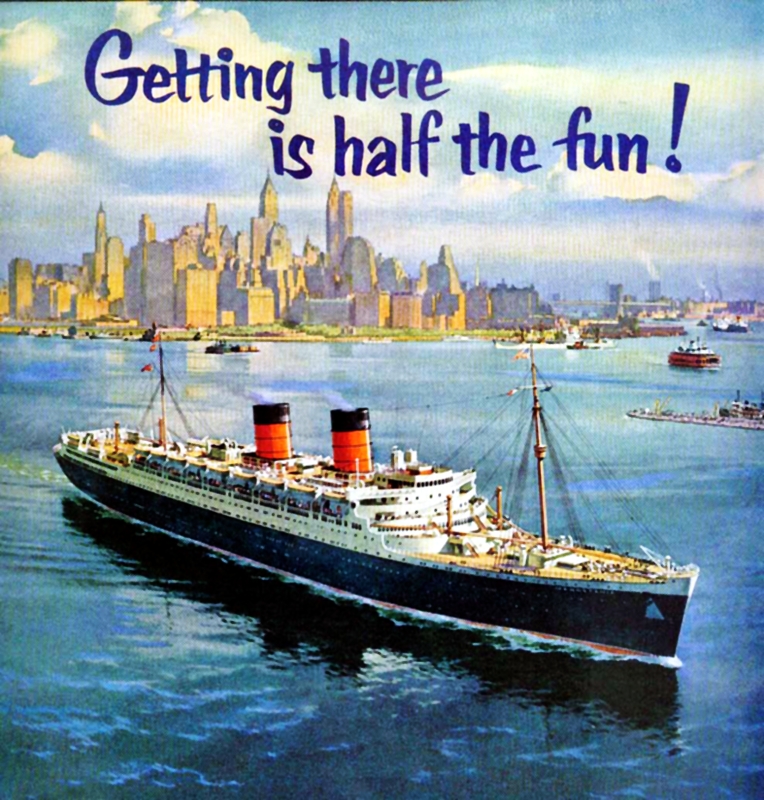
Advertising
was going ahead at full steam for Britain
now had the world’s largest passenger liner!
And
let’s face it: “Getting there is Half
the Fun!”
***********************************
The Trans-Atlantic Liner:
Cunard had already
announced that the world’s largest Passenger Liner ever built would
finally depart on her first ever passenger Trans-Atlantic voyage to New York from Southampton on 16 October 1946.
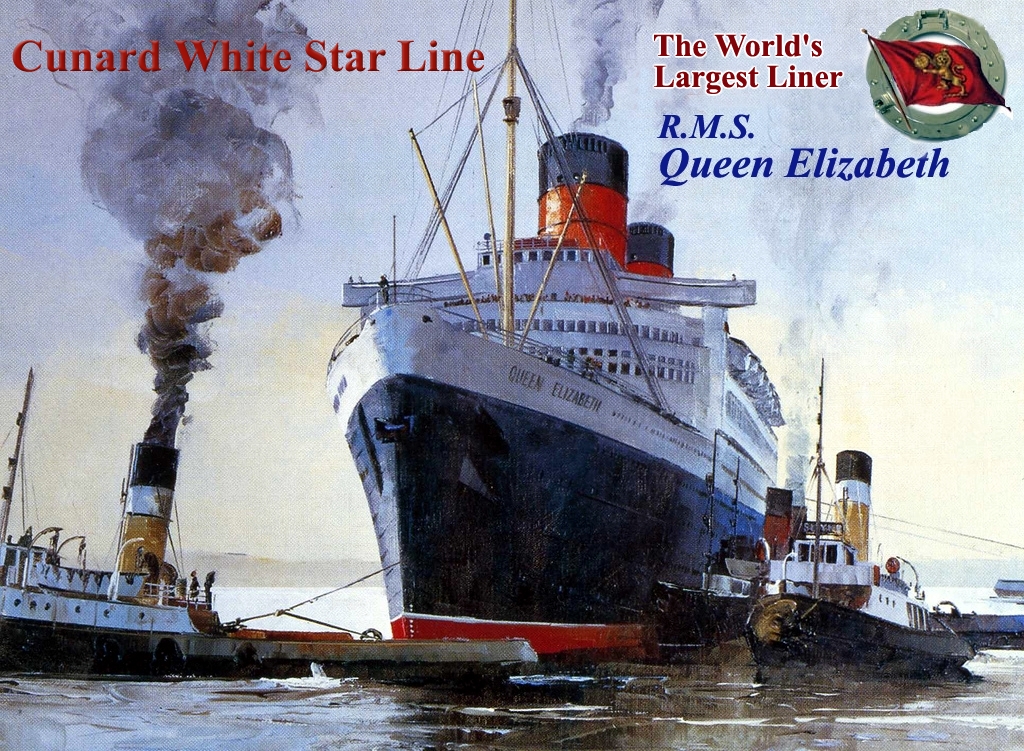
The
result from all the advance media was that the Queen Elizabeth was completely
booked out as were her forthcoming voyages, in addition, if anyone looked at
the First Class passenger lists for a good number of the Atlantic voyages there
would be countless famous passengers, well known names from European Royal
houses, high society, movie stars, great actor’s from the theatre and
some the world’s finest vocalists!
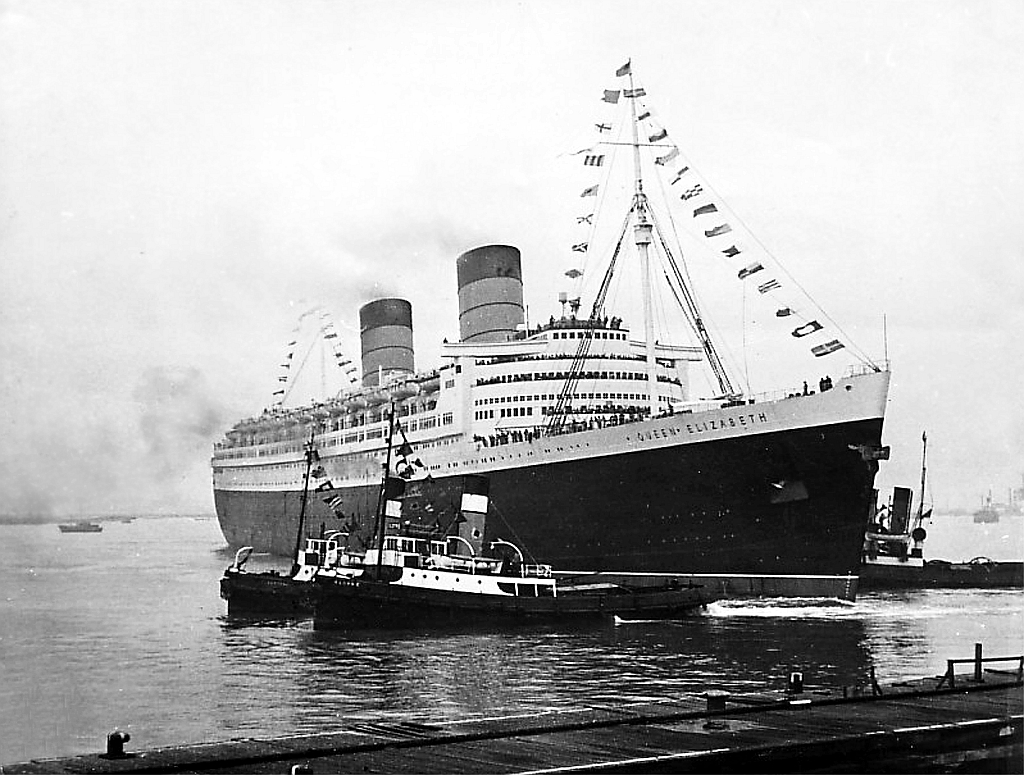
The
moment has finally arrived as RMS Queen Elizabeth departs on October 16,
1946 for her official Maiden Voyage to New York
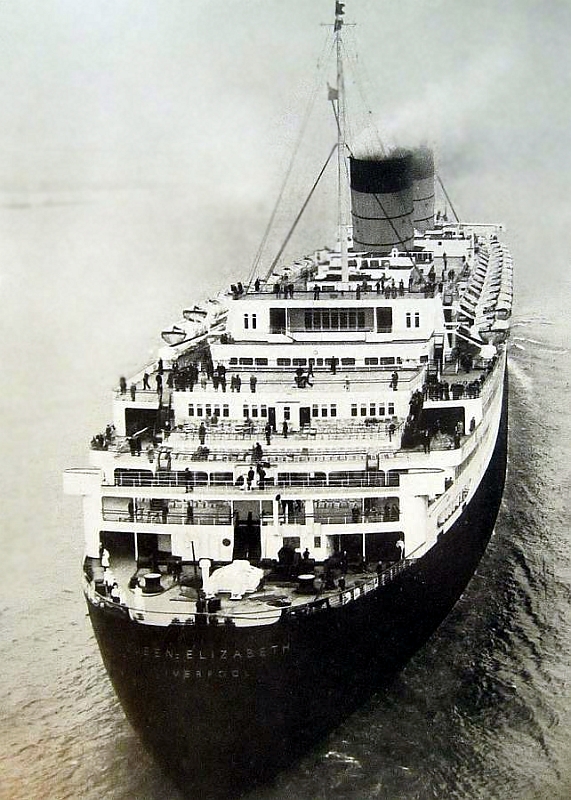
The
Queen Elizabeth is about to arrive at New York
on her maiden visit as a passenger liner October 21, 1946
The
original photograph was clearer and the New York
skyline could just be seen in the distance
But
the copy that was passed down to me from my travel agency was badly damaged and
I had to clean it up & it looks quite good now!
Photograph
by the Port of New York Authority
Obviously,
although she had visited New York
and many occasions in her wartime grey livery, she was not a Royal Mail Ship
(RMS), this time when she arrived she was in addition she looked like a brand
new ship! New York gave her a
grand welcome with all the usual water cannons and ships blowing their horns,
for she had become one of the Great War heroes, but now she was indeed the
world’s largest Trans-Atlantic Liner.
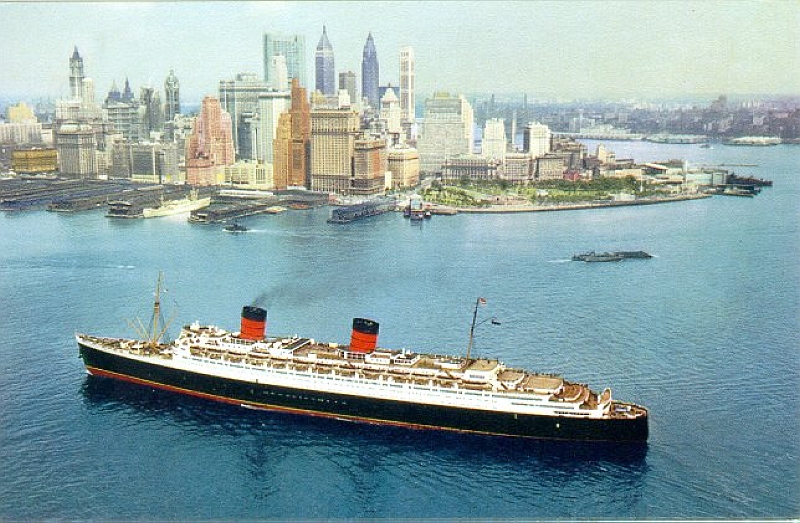
A
delightful early postcard of the Queen arriving at New York sailing up the Hudson River
She sailed on with
great pride, however, on April 17, 1947 she ran aground on Brambles Bank whilst
approaching Southampton
in extremely thick fog. Whilst there was no damage to the ship, in order to
move her off the bank all passengers had to be disembarked
onto boats and go ashore, as well as the bulk of the fuel being pumped out
before the Queen could be refloated the next day. Of course then there is
always the human element, such as industrial disputes like in 1948 that left
the great she was stranded at New York
for two whole weeks.
***********************************
Queen Elizabeth’s Cargo & Provisioning Procedures:
In order to provide an example, I
will take New York on how the
system would work, and this would much apply for both the Queen Mary and Queen
Elizabeth. Queen Elizabeth would usually arrive on a Tuesday and would remain
there no longer than twenty four hours. Obviously
during this time up to 2,283 passengers would have to disembark as well as all
their baggage, and that includes some heavy baggage for those who have arrived
in the US
on a permanent basis! All this would be completed including any cargo from her
two forward holds on Tuesday! Both on Tuesday and early on
Wednesday the stewards and cleaners would be busy with house keeping and
making sure that every inch of the passenger accommodations and all lounge
areas and decks was spotless and ready for their arrival!
I happen to have a list from Cunard White Star
Line and it makes interesting reading: There would be an inventory for 4,100
blankets, 31,000 sheets, and the same
number of pillow slips, 21,000 tablecloths, 92,000 linen napkins, 2,400
bathmats, 2,200 afternoon tea cloths,
and 7,900 aprons.
Obviously Wednesday it would be a complete
reversal to a day earlier, as new baggage would arrive as well as the new
passengers, but more so the ships massive amount of provisions required for the
Atlantic voyage. The requirements were for the freezers and the massive
storerooms for the five day voyage meant some 20 tons of meat, 4,000 chickens
and ducklings, 20 tons of fish, 70,000 eggs, 4,000 pounds of tea and coffee, 30
tons of potatoes, 4,000 pounds of vegetables, 600 crates of apples and oranges,
4,000 gallons of milk, 3 tons of butter, 2,000 pound of cheese, 10,000 pounds
of sugar 60,000 bottles of mineral water, 10,000 bottles of fine wines, 40,000
bottles of beer. In the Galleys there were over 800 saucepans and even an
electric stove that was 16 feet long. A breakfast menu could include 20 types
of cereal, 18 kinds of bread and rolls and 15 different jams and marmalades.
Cunard was most proud about their bacon and the ever spoke of it in their
publicity material that they had 8 different kinds of bacon available for
breakfast. Thus all this would come on board on Wednesday. Also it would be on
Wednesday that Queen Elizabeth would on some 7,000 tons of bunker fuel.
In relation to cargo, it is true that every
major Cunard liner carried some cargo, be it baggage, but also mail, diplomatic
items, antique cars, famous artworks, but and also
gold bouillon.
By September 1951 the Queen Elizabeth had made
its 100th.Atlantic crossing. Despite being a huge success many asked why did she never break any of the speed records, for that was
done by the Queen Mary. But what people did not know that Cunard White Star
chairman Sir Percy Bates demanded that the Queen Elizabeth compete against the
Queen Mary’s “Blue Riband” speed record of 1938 of 31.69
knots, and that is why she was not permitted to go over thirty knots during her
speed trails! Of course later the great American liner, the SS United States took
the “Blue Riband”
speed record of 1952! Although the Queen Elizabeth was
capable of a good 32 knots!
***********************************
Overhauls and Refits:
During January
1952 she received an overhaul as well as the ship's fuel capacity being
increased and finally air-conditioning fitted throughout the ship. However,
once again several mysterious fires broke out in several of the passenger
cabins but thankfully were quickly extinguished and completely refurbished.
Then in January 1955 came one of the more welcome additions, regardless of her
size, but to be fitted with Denny Brown stabilisers was a godsend during those
winter months! But, times were’a’changing
as slowly people were taking to the sky as planes became a status symbol with
the wealthy, and First Class traffic was the bread and butter for Cunard Line!
Thus even these improvements, were not quite enough for these grand luxurious
passenger liners to compete with air travel, and by the time of the late 1950s
sadly, now there were more people crossing the Atlantic by air than by sea and not just the
rich!
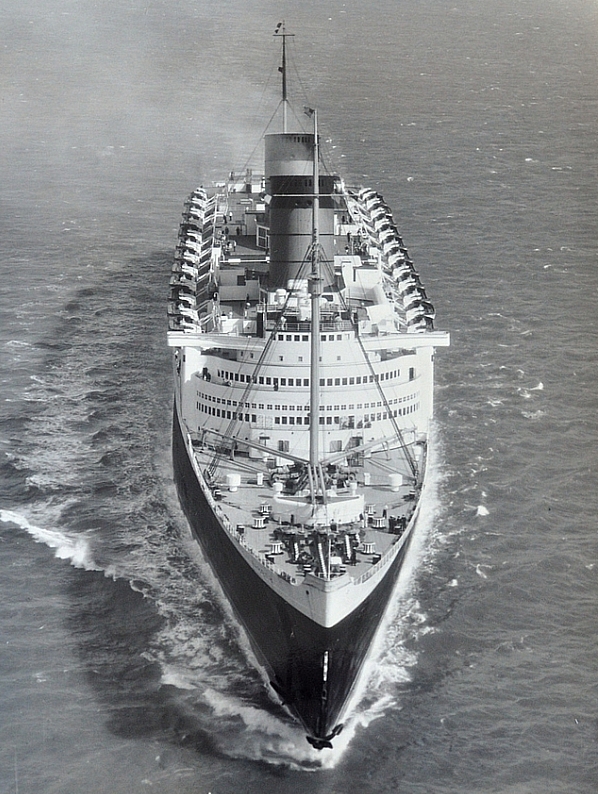
A
wonderful bow angle taken from the air of the RMS Queen Elizabeth
Things did not get
better as on July 29, 1959 the Queen Elizabeth was involved in a collision with
the ‘American Hunter,’ being a United States Lines cargo ship. The
collision occurred in the Ambrose Channel when both ships were outward bound
from New York. During thick fog it was the American ship that struck the starboard
bow of the Queen Elizabeth but, luckily, damage to both ships was not
too great, but the Queen was holed just above the water line and temporary
repairs were quickly carried out at New York.
There was no doubt that the great Queen
Elizabeth became the ship to sail on in the 1950s and 60s and besides Royalty
it would be the British, European and especially the American greatest artists
of their time who would book on her, and of course they would make sure that
they were not only seen on her but photographed by the media, as we will see in
the photographs below!
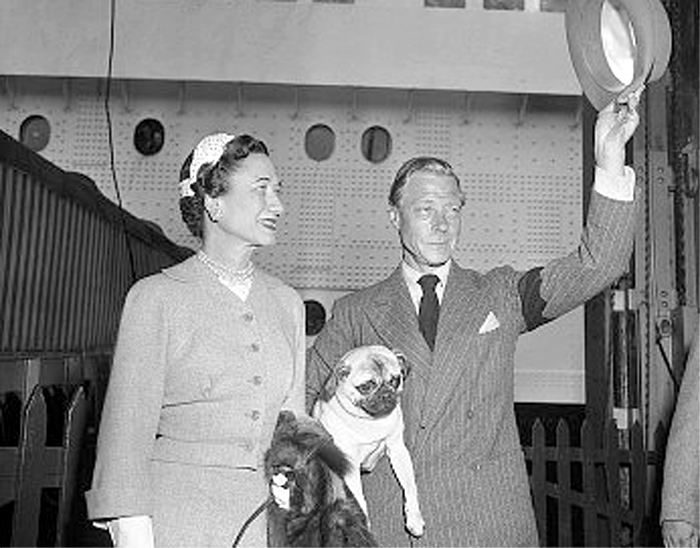
Here
we see the Duke and Duchess of Windsor ready to board the Queen Elizabeth with
one of their pug dogs
This
would have been in the late 40s or at least before 1952
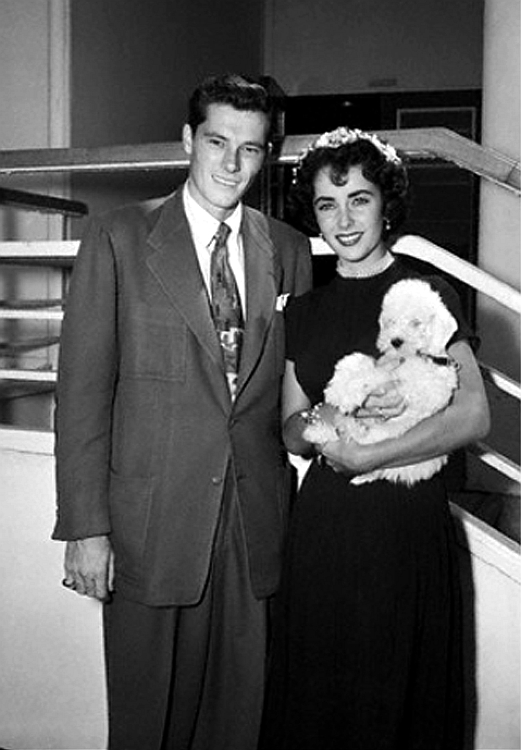
The
talented and sublimely beautiful Elizabeth Taylor with her dog
in her arms is seen with her husband Conrad “Nicky” Hilton
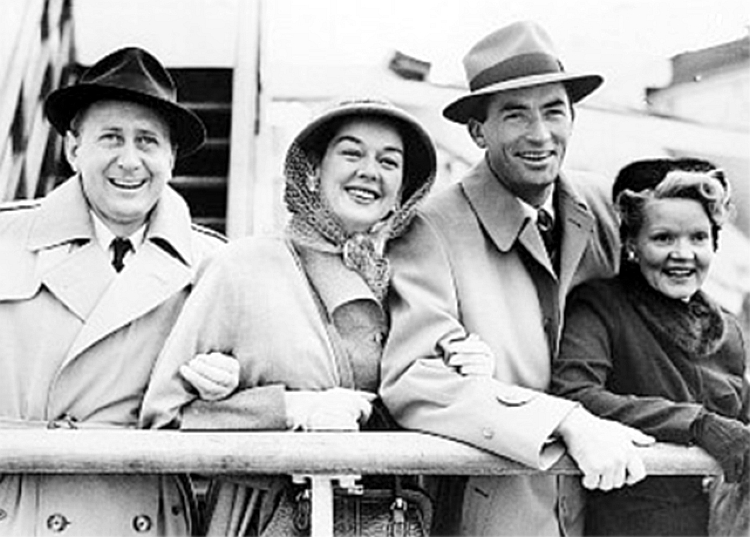
As
the great Queen is ready to depart, we see at her railings from left to right:
Frederick Brisson, his then wife wonderful Rosalind Russell-Brisson, Gregory Peck and his wife Mrs. Peck
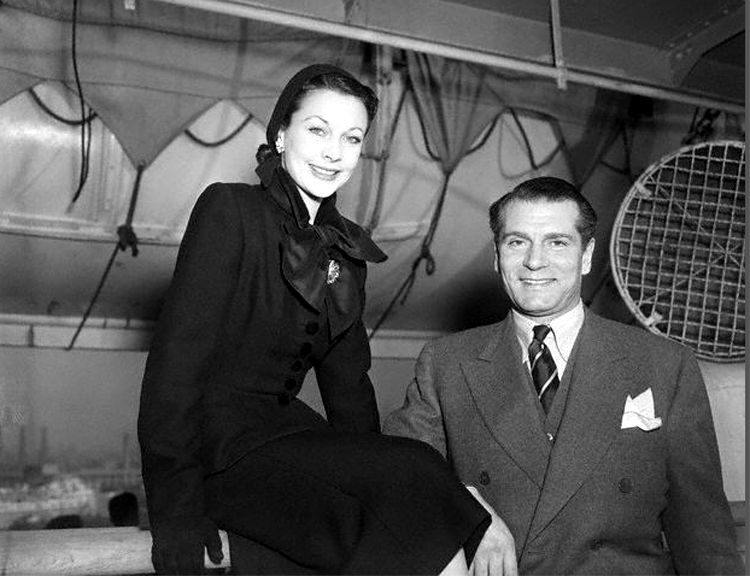
The
lovely Vivien Leigh and one of the greatly talented Lawrence Olivier
on board the Queen
In those days
to be invited to the Captain’s Table was a very special honour and
regarded as one of the great social events. For
those from the world of high society it was ver much
expected to be invited one or another of these special dinners! If there was
ant Royalty on board, be it from one of the European countries they would dine
at this table, like other important guests, whilst should there be British
Royal guests, then they usually would dine with the Captain in his private
spacious Dinning Room. Thus in those days this table was only available to six
important guests and should there be more a second event would be held.
In the photograph below we see the six from
left to right clockwise from the ships Captain Charles Musgrave Ford are; Lady Enisdale
and Lord Enisdale, Mrs. MacDonald and Mr. Ian
MacDonald, Captain H. Harrison-Wallace and Mrs. Harrison-Wallace.
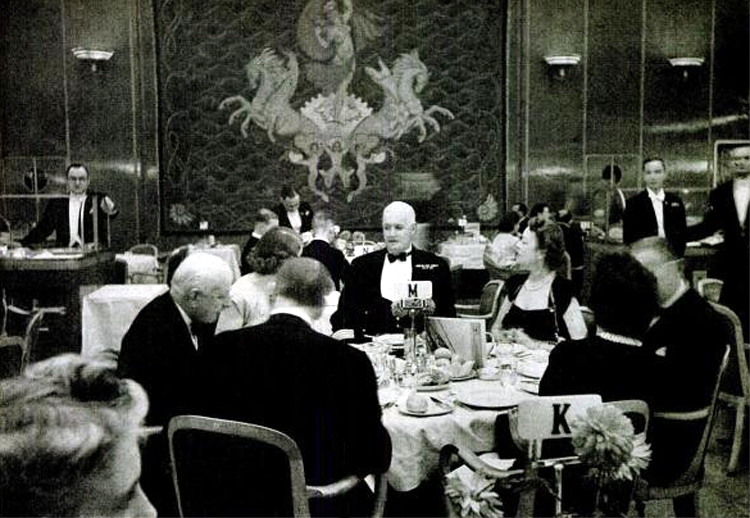
Here we see the
Captain’s Table with his official guests as per above list!
From 1960 onwards, she received
progressive improvements and modernisations to all three classes that saw
lounges, cabins and general facilities improved.
***********************************
Queen Elizabeth the Cruise
Ship:
But the decline in
passenger numbers became so great, that at times there were more crew than passengers on board the ship, in fact on one voyage
considering there was a crew of 1,200, there were only 200 passengers on board.
Considering the situation in 1962 Cunard made an announcement
that the Queen Elizabeth would commence cruising in 1963.
She departed on her very first pleasure cruise
in February 1963 from New York
to Nassau and these
proved to be popular. Whilst on one of these cruises there was a rather unusual
incident as a light aircraft crashed into the sea not that far from the stern
of the ship. I am told that this occurred south-east
of Cape Hatteras.
Sadly the pilot died upon impact. Obviously, the ship notified the coastguard.
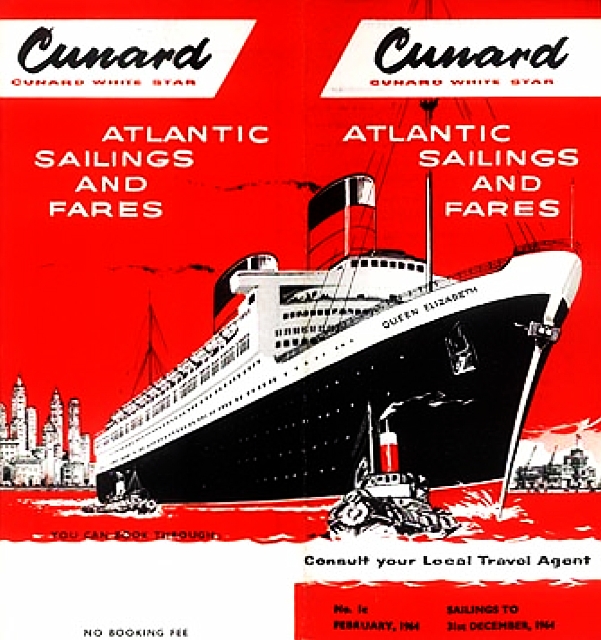
Fare
and sailing schedule for February to December 1964, after which she would
cruise in America
Then in March 1965
it was announced that the Queen Elizabeth would be receiving a major overhaul.
She arrived in Greenock
on December 5 and the work commenced. The main chances would include extensive
redecoration of her public rooms and her accommodations, as well as enhancing
the air-conditioning system. Externally there would be the extension of the aft
deck, being the creation an extensive Lido Deck with a brand new open-air
swimming pool added with glazing along the sides the two aft decks. Although
the work was completed by April 1966, although there was a several weeks delay
due to a seamen's strikes. Her new tonnage was listed as 82,998 GRT. Thus now
the great RMS Queen Elizabeth would operate Trans Atlantic voyaged during the
summer months and cruises to the warmer climates during the winter.
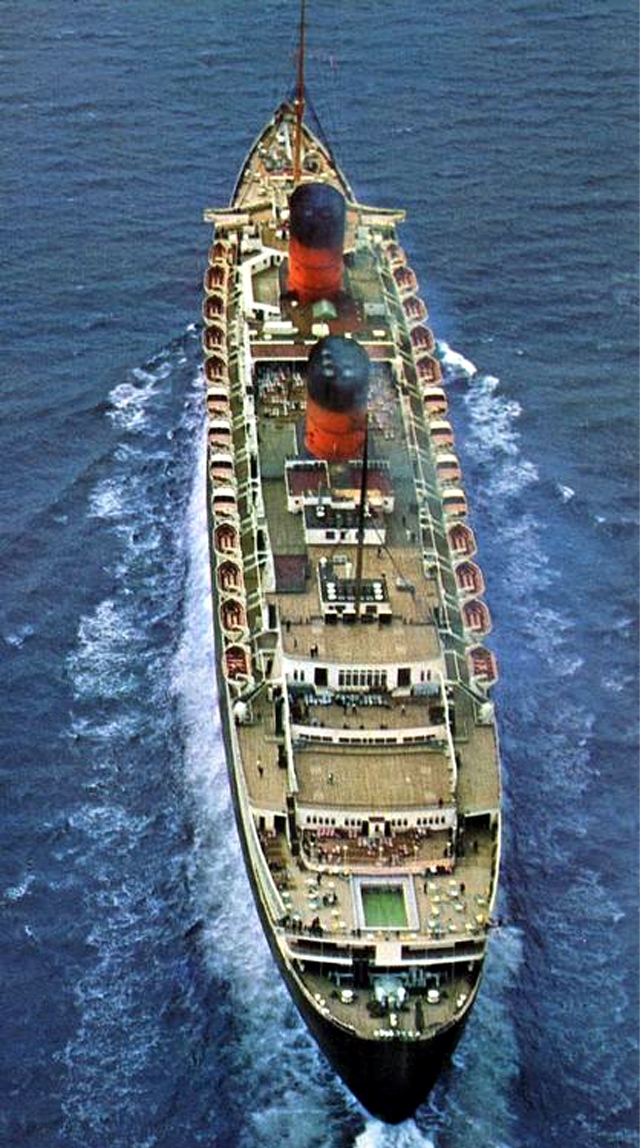
This is a superb areal image
looks at her new extended aft decks and her new swimming pool. I took it from a
1967 Cruise brochure from my collection. Sadly these days, modern cruise
ships just do not have such spacious open deck spaces, and many do not even
have a full walk around Promenade Deck anymore! The photograph is from the author’s private
collection.
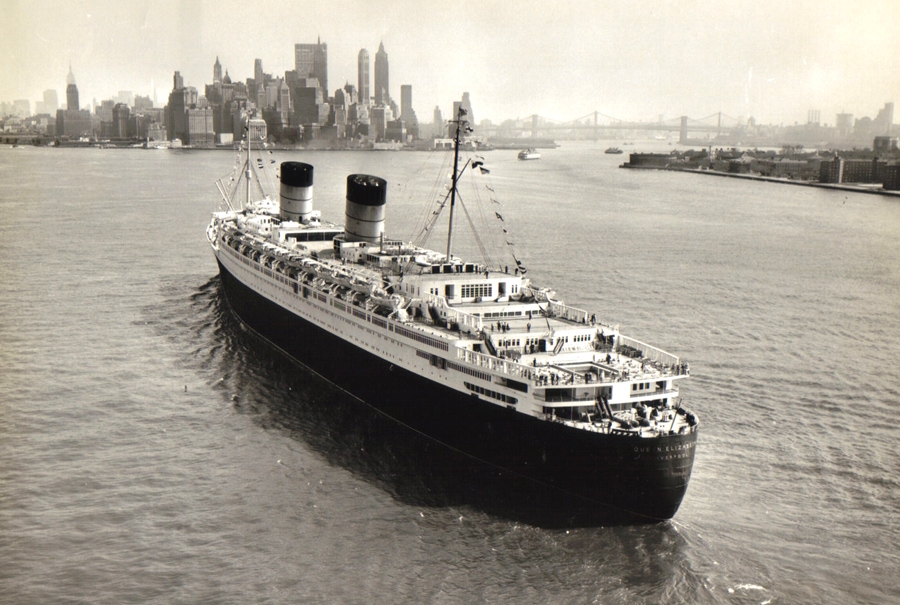
RMS
Queen Elizabeth arrives at New York
on April 4, 1966, but here she shows of so beautifully her new aft Lido deck and pool
Photograph
by the Port of New York Authority
Thus soon she
sailed looking simply splendid with her new aft section and her interiors were
better than ever before and from all reports passengers fell in love with the
great Queen Elizabeth all over again, and bookings were doing quite well. But,
costs and her rather deep draught was a big problem, for she simply could not
get her anywhere near some of the most popular ports and islands, and that is
just where so many people desired to go, for they had heard of these places in
advertisements in brochures from other cruise companies and other ships visited
there on a regular basis, thus that caused a bit of a problem for Cunard, but
it could have been worse, but there was big competition from Italian and other
lines from around the world, but not by other English ships!
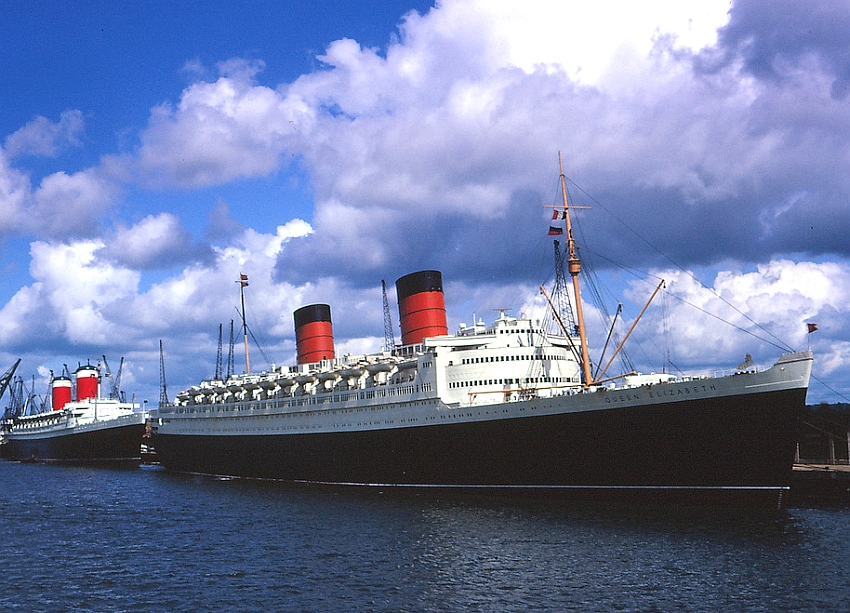
In this rather unique
photo we see the both the great RMS Queen Elizabeth and America’s
greatest ever liner built
the SS United States, which
Thankfully remains with us today, and she will be restored in due
course!
I would assume that
this excellent photograph was taken sometimes in the mid sixties.
This
photograph was sent in by a supporter, but the photographer is unknown -
*Please see photo notes at bottom of page!
Then suddenly there
was an official announcement on May 8, 1967 that the RMS Queen Mary would be
withdrawn from duties later that year and on August 18 that year she was sold
to the city to Long Beach, California to be refitted as a
Hotel. The great liner departed Southampton on a special extended cruise packed
with ship lovers from around the world sailing for Long Beach,
being her very last ever voyage. Having arrived there and after a long
conversion she was laid up and became ‘Hotel Queen Mary’ and she
remains so to this day!
There was one big problem
that had been ongoing for Cunard, and it was
with great sadness that it was also announced on the very same day of the Queen
Mary’s announcement of her demise, on May 8, 1967 that the Queen
Elizabeth would also be withdrawn, but much later in 1968. Some have asked,
“What in reality was the final nail in the coffin for the great
Queen?” Let me try to explain what was a huge problem of the times, for
after her massive refit in 1965 that was followed by the various seaman strikes
that was so common in those days, this cost Cunard White Star Line a mammoth
£14 million Pounds, and let’s face it that kind of money is hard to
recover for that is a massive loss, especially in the nineteen sixties, thus
sadly it would be the seaman’s union’s doing that aided in killing
the great RMS Queen Elizabeth before her time! I am all for the sailor, always
have been, but I am afraid there are some unions that have a great deal to
answer for, shame on them! Here in Australia
the seaman’s union have completely destroyed our
own seaman’s industry, and now we have just a few bare bones left in the
industry and frankly I am ashamed of what is left! But the British Unions are
known worldwide as being the worst in the world!
If you wish to view the R.M.S.
Queen Elizabeth’s’ Deck Plan, may I suggest that you visit the
following excellent Website on her,
but on this one in particular you
will also discover her entire deck plan!
http://www.rmsqueenelizabeth.com/DECKS.html
Please ensure that your pointer is pointed directly
on the RED letters to open each deck - I did find that “C Deck”
did not open!
***********************************
The Queen’s last
Atlantic voyage and at Port Everglades:
The great liner,
the RMS Queen Elizabeth made her rather sad and final Atlantic crossing from
Southampton to New York
on November 5, 1968, few knew that she had already been sold to a group of Philadelphia
businessmen who had commenced the “Elizabeth Corporation” for £3.25
million Pounds, but Cunard Line retained an 85% controlling interest in the
Corporation. Once she arrived in New York
she headed for Port Everglades, where she arrived on December 8, 1968.
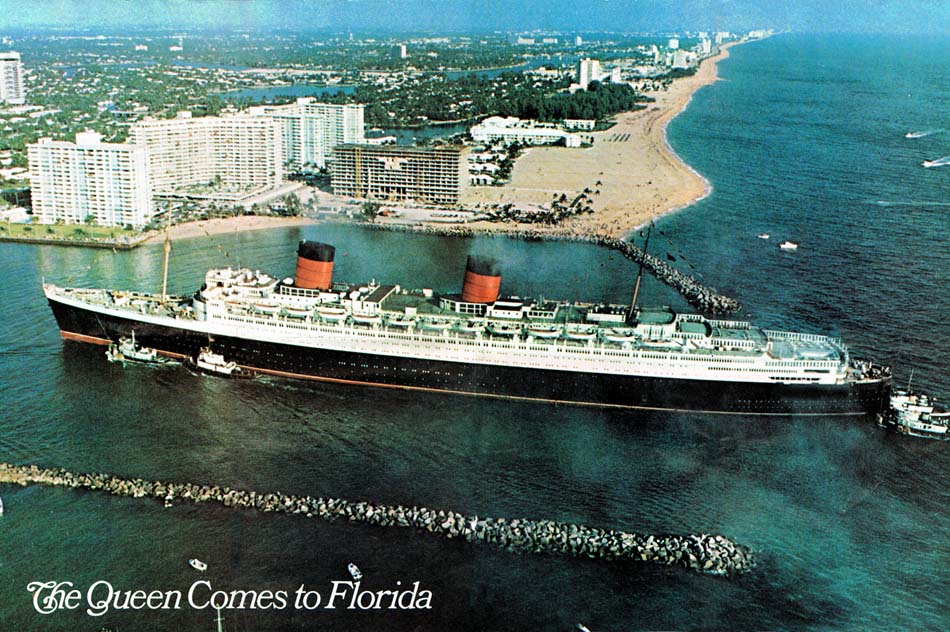
Here
we see the great Queen arriving at Port Everglades on December 1968
This
photograph was together with the article shown below
Photo sent in by
Russell L. Weaver and article found by Wendy
Lueder when going through old newspaper clippings
The purpose of the great liner
being in Port Everglades was become a convention centre and a major tourist
attraction and she was partially opened to the public in February 1969.
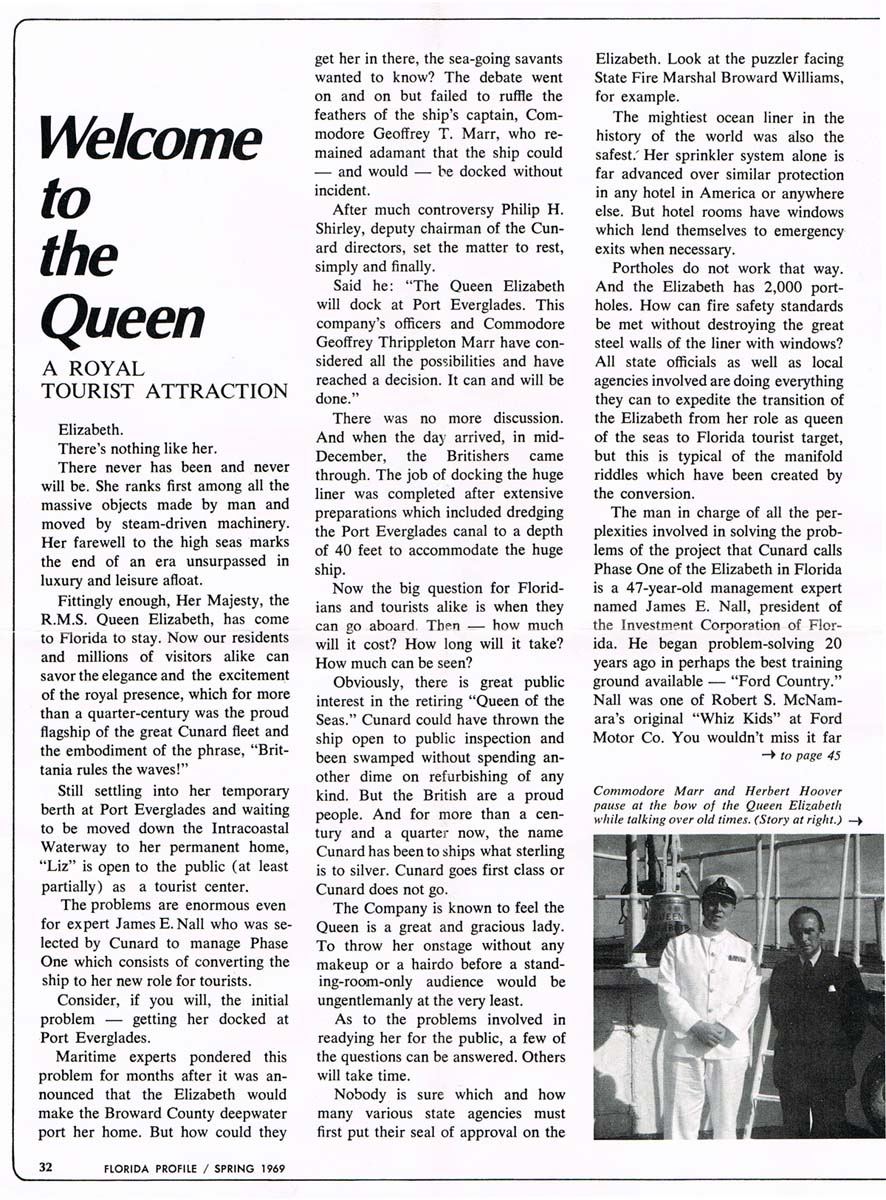
Page one of an article in the
“Florida Profile issued in March or May 1969
Sent in by Russell L. Weaver and article found by Wendy Lueder when going through old newspaper
clippings
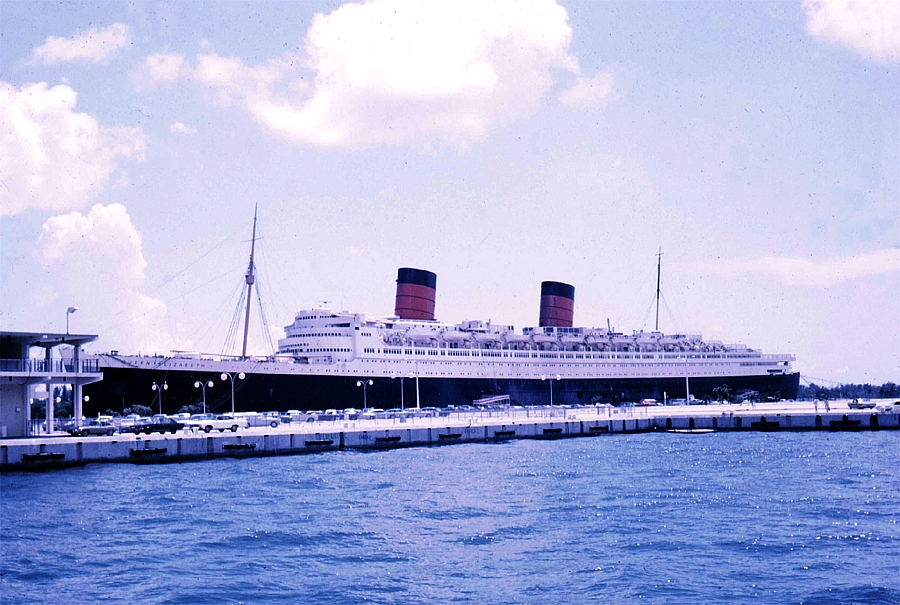
Here
we see the Queen Elizabeth berthed at Port Everglades in November 1969
This image was sent in
by a supporter, but the photographer is unknown - *Please see photo notes at
bottom of page!
However months later, on July 19
she was sold to Queen Ltd of Port Everglades, and she was simply rename “Elizabeth.”
They, like her previous owners also used her as a tourist attraction and
intended to greatly upgrade her according to the authorities’
requirements.
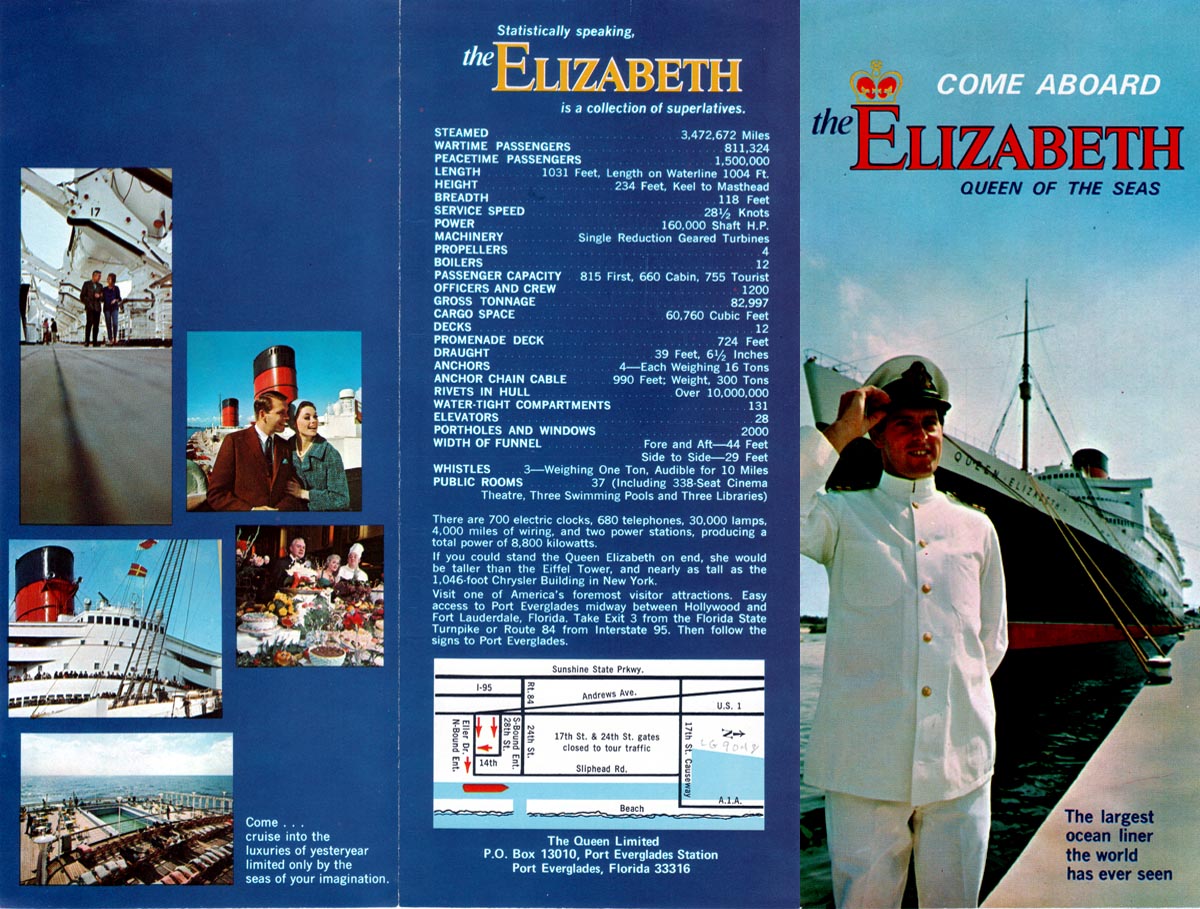
Above & below: this the
“the Elizabeth”
brochure released by Queen Ltd in 1969, I also have an ashtray from the ship
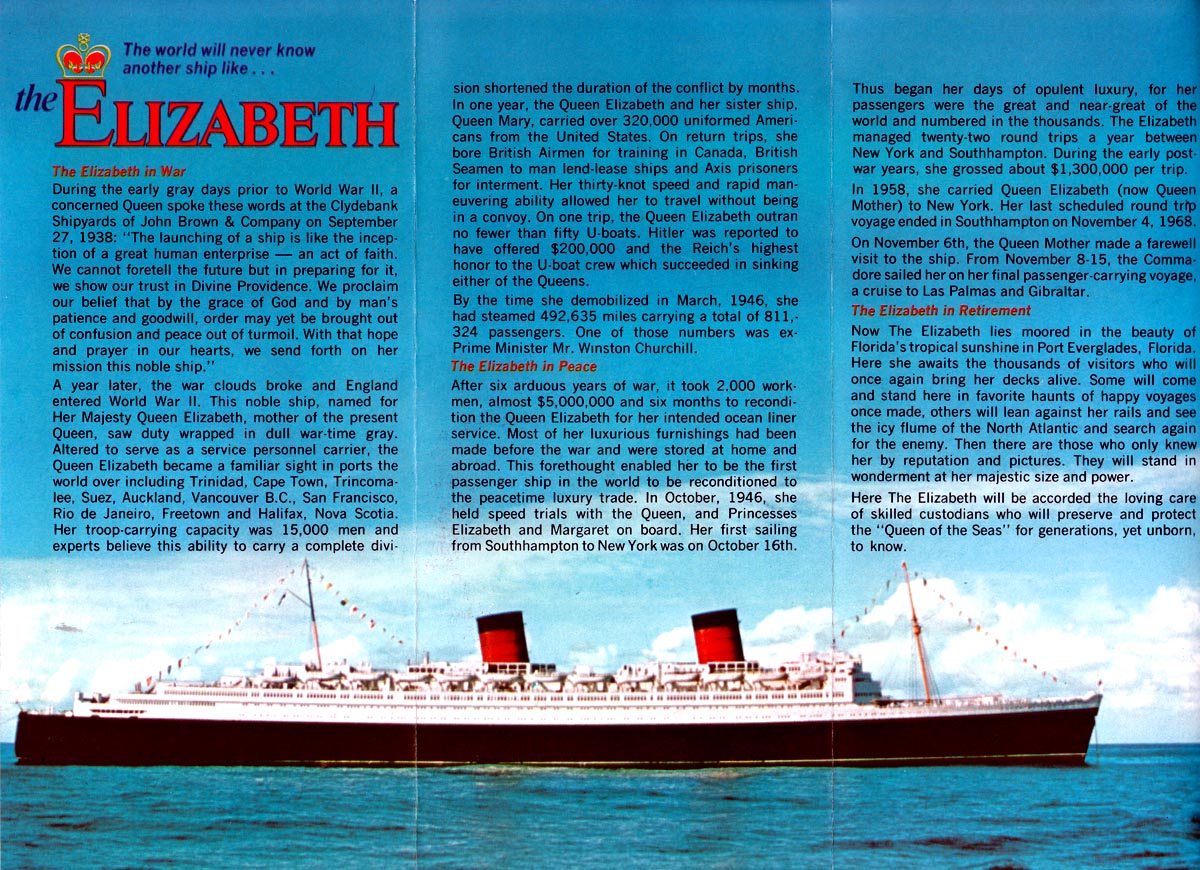
However, just after a year of trading, in
August 1970, Queen Ltd went into bankruptcy and soon the liquidators placed the
great Queen up for auction!
***********************************
SS Seawise University:
The great Chinese
Ship Owner Mr. C.Y. Tung, who over the years obtained many fine liners and
operated them all successfully, he heard late in 1970 that the great ex Queen
Elizabeth was up for auction thus he decided he wanted her for his new floating
university! Being the successful bidder under the name of Seawise Foundation
Ltd, the Elizabeth
was renamed Seawise
University
and she sailed for Hong Kong
on February 10, 1971.
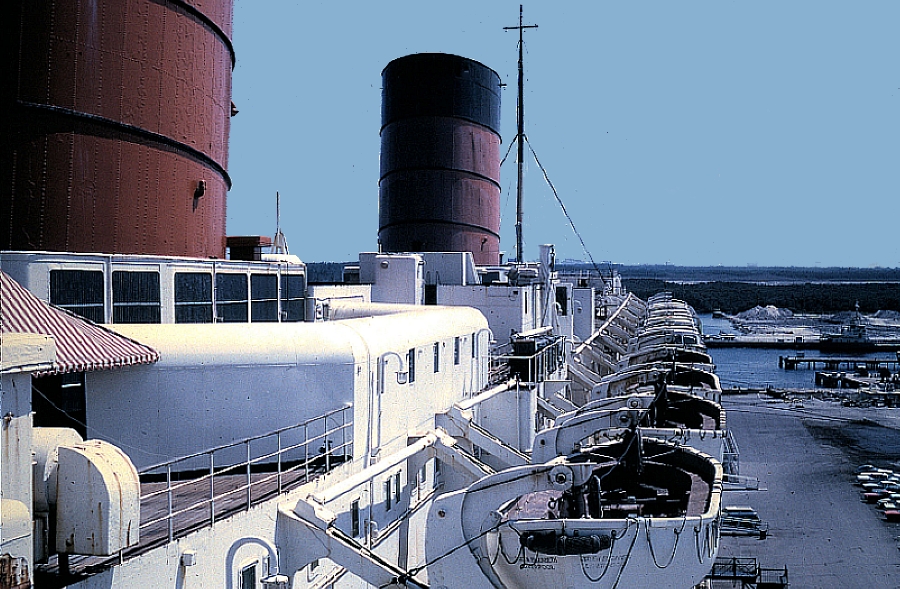
Elizabeth,
renamed Seawise University is seen just prior to her departure from Port
Everglades
This
image was sent in by a supporter, but the photographer is unknown - *Please see
photo notes at bottom of page!
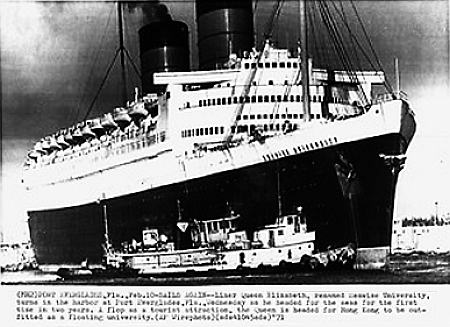
SS
Seawise University departs Port Everglades for Hong Kong on February 10, 1971
This
is a new item found in the local new paper detailing the ship being “a
flop” locally
However, during
her rather unexpected lengthy voyage the SS Seawise University encountered
ongoing boiler problems, therefore she did not arrive in Hong Kong until July
and upon arrival she was placed at anchor just off Tsing
Yi Island near Kowloon, for it would be there where she would be converted to
hr new owners needs!
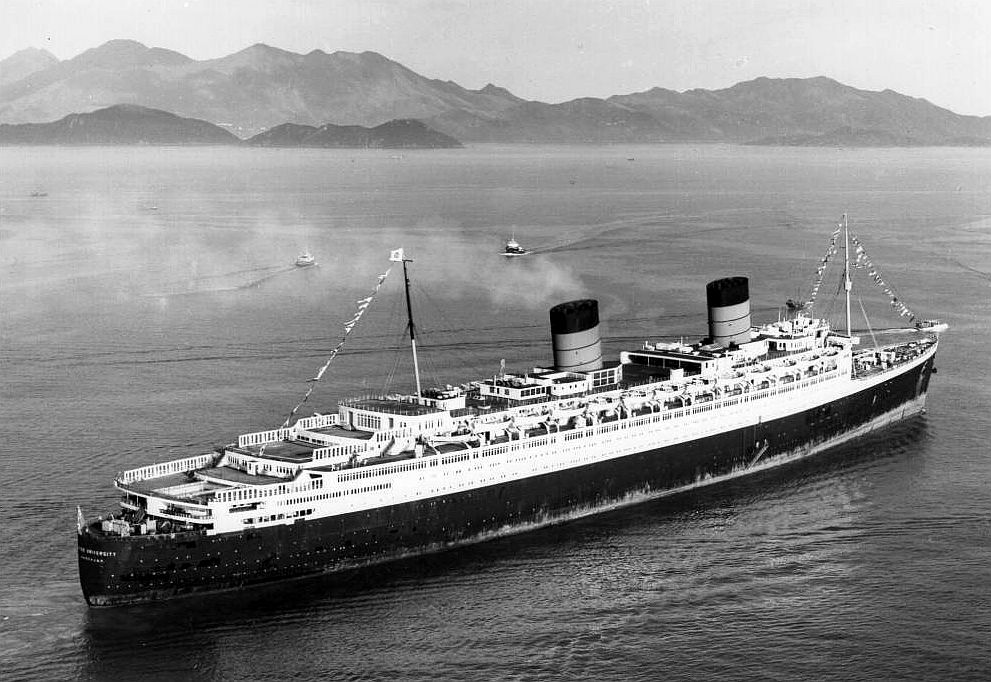
The
Seawise
University
arrives at Hong Kong
in July 1971
Mr. C.Y. Tung
desired to utilise the great ship in a dual role, as a floating university, but
also as a luxury cruise ship. With this in mind, work soon commenced with a
massive £5 million Pound (for the day overhaul and refit of the ship into a
university and cruise ship. Thousands of labourers descended upon the ex Queen
Elizabeth to carry out the task of converting the ship.
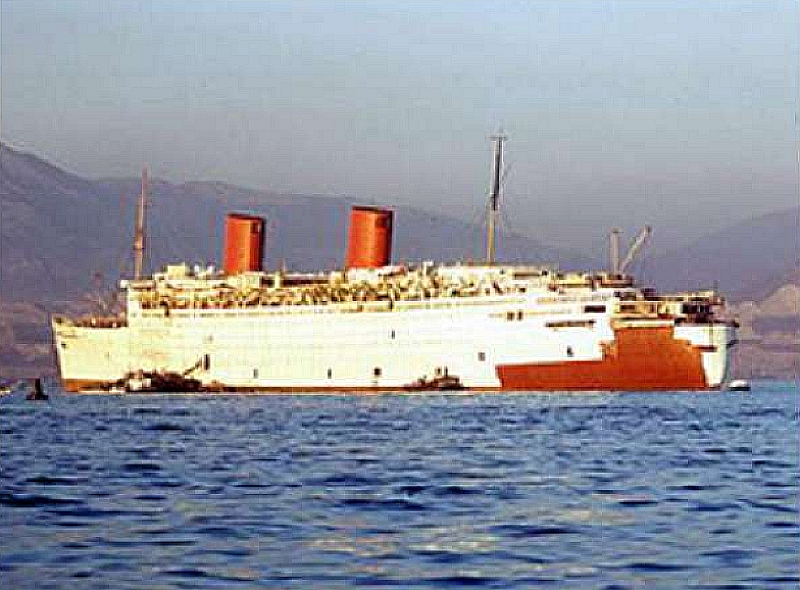
The
Seawise University undergoing
her refit at Tsing Yi Island
Photographer
is unknown - *Please see photo notes at bottom of page!
The ship was
stripped down and built back up. Modern equipment was installed to ensure
safety at sea, and certain areas of the ship were given a decidedly
‘oriental’ décor. By December 1971, the work was close to being
completed, thus there was great happiness in the Tung family and all that had
worked so hard on board, for they had done a very good job indeed!
***********************************
Tragedy Strikes the old
Queen!
From all reports
that I have heard, the security on board was close to non existent, for
let’s be honest, the only people that came on board were the workers and
staff, visitors had to have an official pass, and there were several security
men on board, but it was far from being a CIA operation, for the ship was at
anchor and not at a berth!
On January 9, 1972, the ship so close to
completion and she was scheduled to sail for Japan
quite soon where she would be a dry docked and from
there she would go on her maiden voyage. But sadly that was not to be, for the
whole of Hong Kong
was about to be awakened with a massive funeral pyre as five separate fires
were discovered around the ship. These fires spread very quickly and the ship
burned throughout the night. It was immediately obvious that these fires had to
be purposely lit by an individual, or individual, yet it had never been
officially been proved.
Then on January 10, the great lady commenced
to keel over to starboard as the hulk continued to burn and smoulder for over a
week. There was just one casualty, but the Seawise
University
was in bad shape and now only suitable for the breakers.
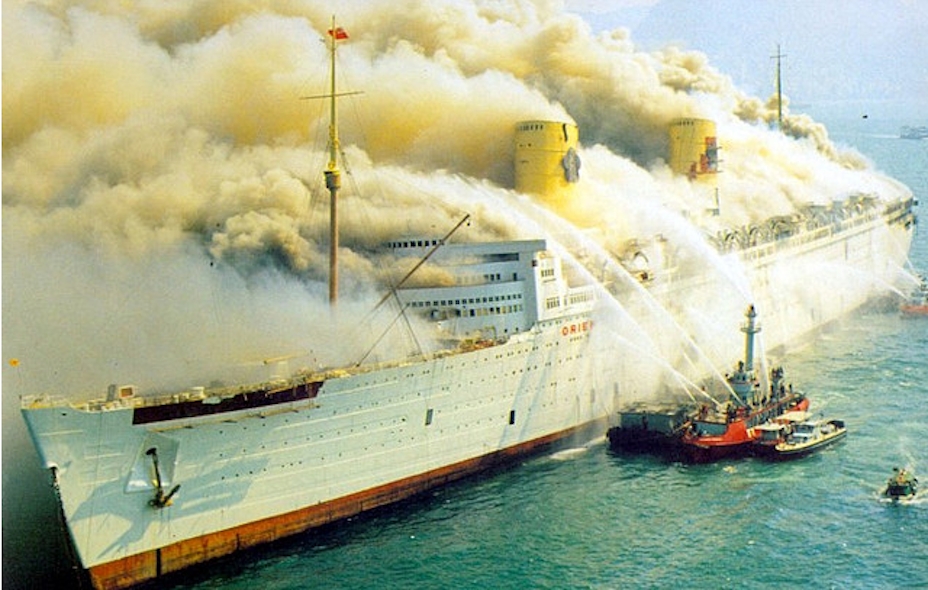
Seawise
Queen is seen ablaze in Hong Kong
Harbour
Photograph
South China
Morning Post
------------------------------------------------------------------
Below, is the text of a Letter sent from
Her Majesty Queen Elizabeth the Queen Mother to Mr. C.Y. Tung.
“Clarence House.
S.W.1.
13th January 1972.
Dear Mr Tung,
I am to tell you how deeply distressed Queen
Elizabeth the Queen Mother is at the disaster which has overtaken the liner which was launched by Her Majesty and bore her name. Ever
since Her Majesty learnt of the plans you had for Seawise
University,
Queen Elizabeth had felt a very keen interest in your enterprise and hoped from
her heart that the great liner would have many years of useful service. Alas,
it seems that this is not to be and the Queen Mother asks me to send you her
very sincere sympathy in the tragedy which has anyhow temporarily dashed your
hopes.
Yours sincerely,
Martin Gilliat.
Private Secretary to Queen Elizabeth the Queen Mother”
------------------------------------------------------------------
An enquiry in July 1972
confirmed that it had been the work of an, or arsonists, however the
criminal(s) was never found. In December 1973 it was decided to scrap the hulk
and Japanese breakers would do the job. However, during this time, the wreck
was used during the filming of the 1974 James Bond movie “The Man With the Golden Gun” that portrayed the ship as the
MI6s Hong Kong’s headquarters.
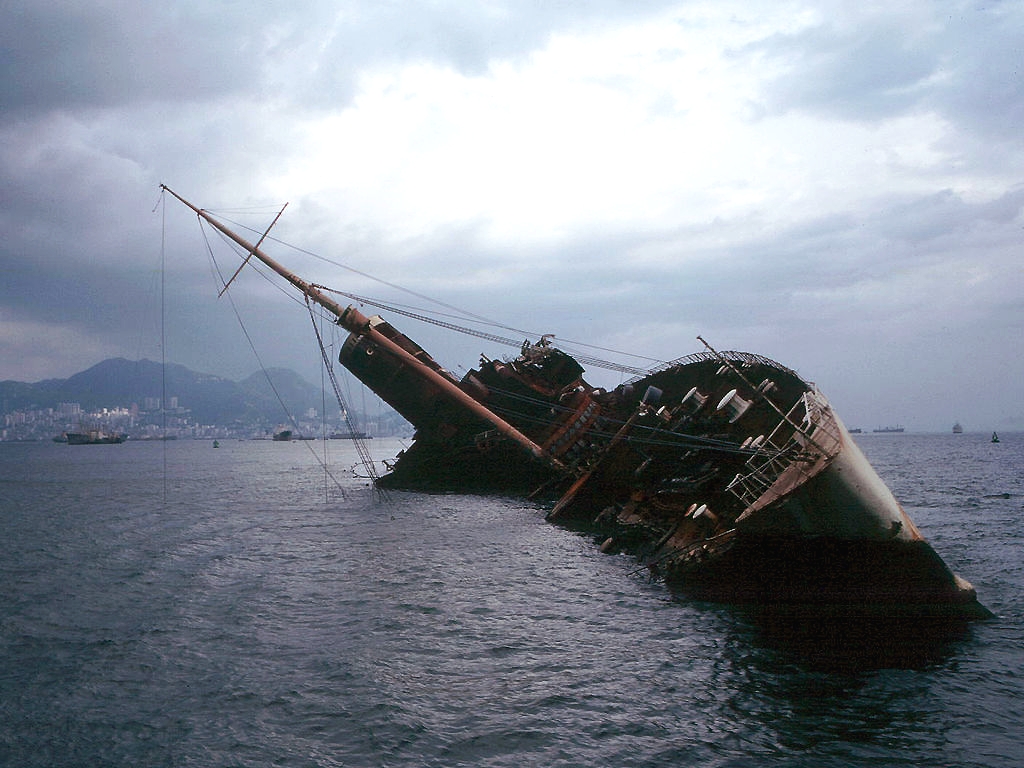
Seawise
University seen keeled well over in Hong Kong
Harbour
in July 1972
Photograph
by & © Barry Loigman
But then there was
the ship's final protest on November 5, 1975 when she rolled over and she
spewed out several tons of oil that polluted the surrounding waters as well as
some of the beaches. The official position of wreck is: 22°19.717'N 114°06.733'E? / ?22.328617°N
114.112217°E, also? / 22.328617; 114.112217 the RMS Queen Elizabeth held the title of “largest passenger
shipwreck,” well that was until the recent MV Costa Concordia disaster in
2012.
I was sent this item of interest by one of
my readers, although I am unaware of its source:
“Parker pens produced a special edition of 5,000 pens made from material
recovered from the wreck in a presentation box and these are highly collectible
Two of the ship's fire warning system brass plaques were recovered by a dredger
and these are now on display at The Aberdeen Boat Club in Hong Kong within a
display area about the ship. The charred remnants of her last ensign were cut
from the flag pole and framed in 1972, and it still adorns the wall of the
officers' mess of marine police HQ in Hong
Kong.”
Although a great deal of the Grand ex RMS
Queen Elizabeth was scrapped and removed, a remnant did remain and you may ask
– “Where is the that part of wreckage today?” The
following is from the South China
Morning Post – January 6, 1997.
Almost exactly a quarter of a century after a
mystery blaze destroyed the Queen Elizabeth in Victoria
Harbour,
the once-proud ocean-going liner is to find her resting place buried under
Container Terminal Nine (CT9).
Reclaimed land on which the terminal will be
built is to extend over the area where the wreck of the once majestic liner
lies.
Arsonists who started the fire off Tsing Yi Island on January 9, 1972, have never been
identified.
And the reason why she was set alight as
shipping boss C.Y Tung, the father of Chief Executive-designate Tung Chee-Hwa, moved to turn her into a $30 million floating
university has never been explained.
Early CT9 consultancy studies raised concern
over the effect the wreckage might have on the project and shipping in the
area.
But now, with only months before the before
the head of the famous shipping family takes control of the territory, the
mystery of his late father’s pride and joy is to be buried forever.
In the coming months the section of Tsing Yi will become reclaimed land, eventually housing the
southern berths of CT9.
The Port Development Board’s commercial
consultant Peter Glass said: “Original studies looked at the wreckage of
the Queen Elizabeth as a possible problem but that is no longer the case. The
reclaimed land will extend over the area where her wreckage is sited.”
***********************************
Statistics:
Bulder: John
Brown and Company Clydebank, Scotland.
Slipway: 4 – Hull number 552.
Laid
down: December 4, 1936.
Launched: September 27, 1938.
Port of Registry: Liverpool, United Kingdom.
Maiden Voyage 1: March 3, 1940, entering her wartime duties.
Maiden Voyage 2: October 16, 1946, being her first ever passengers service!
Gross
Tonnage: 83,673 GRT - 82,996 in 1965. 16,881 d.w.
Length: 300.94m - 987.4ft.
Breadth: 36.14m - 118.6ft.
Draught: 12.07m – 39.6ft.
Engines: Parsons single reduction
steam turbines, by John Brown – 160,000 SHP.
Screws: Quadruple screws.
Speed: 29 knots – Max 32
knots.
Passengers: 2,283
passengers.
823
First Class, 662 Cabin Class and 798 Tourist Class.
Crew: 1,296.
Names: 1.
Queen Elizabeth. 2. Elizabeth. 3.
Seawise University.
1.
1939–1969. 2. 1969–1970. 3. 1970–1972.
Owners: 1939-1949: Cunard White Star
Line.
1949-1968: Cunard Line.
1968-1969: The Queen Corporation.
1969-1970:
Queen Ltd.
1970-1972:
C.Y. Tung - Seawise Foundation Ltd, Hong
Kong.
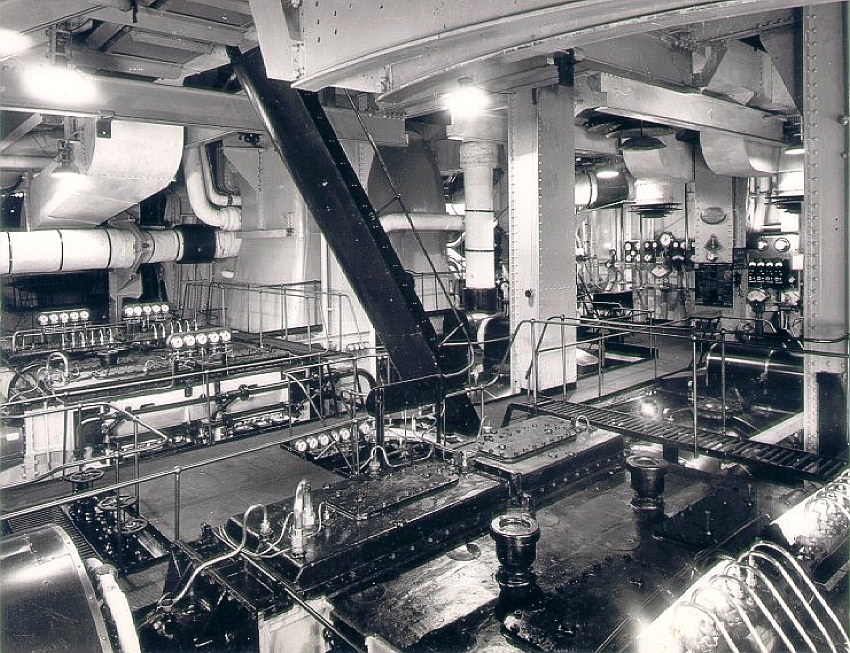
Part
of Queen Elizabeth’s engine room
***********************************
The Other Queens - RMS Queen Elizabeth 2 – QE2:
The replacement for the two older
liners came in the form of a far more modern liner, being the RMS Queen
Elizabeth 2, or the ship that became so lovingly known worldwide as the QE2!
This wonderful looking steamship was launched by HRH Queen Elizabeth II on
September 20, 1967, and she sailed on her maiden voyage from Southampton to New
York on May 2, 1969, whilst the ex RMS
Queen Elizabeth was still berthed in Port Everglades.
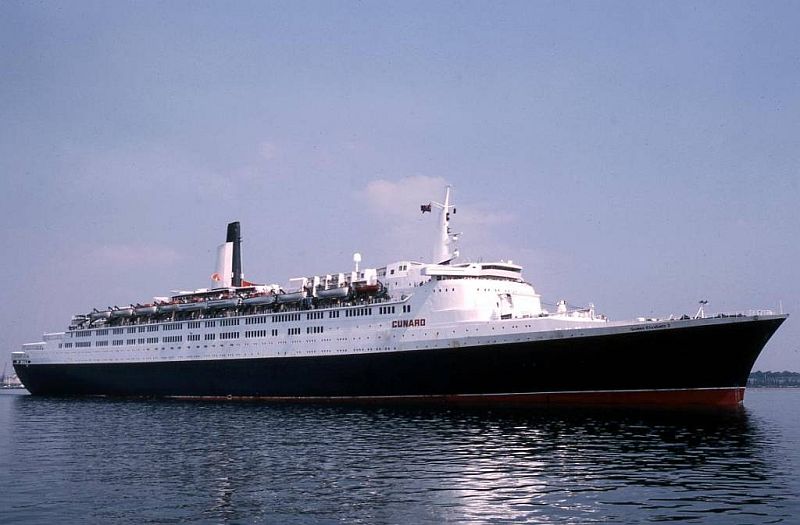
The
long and sleek Queen Elizabeth 2 (QE2) seen as built
The 63,868 GRT QE2
had a troubles from the start as she suffered problems during her Media and
agents run in voyage, as Cunard put it mildly “teething troubles”
with her steam turbines. Thus her official delivery was delayed by four months.
Later she received new engines and became a motor ship, thus became a far more
economical ship, as well having fewer problems in the future! In additions, she
had a number of looks from her slim line tall black funnel encased by a white
sleeve that surrounded it with only the forward part showing, but this would
aid the removal of any smoke from the decks. Her hull colour changed from
black, shell grey and a royal (dark) blue. Her funnel also changes where the
white received the red and black stripes, but later she was given a shorter,
thicker new funnel that made her a better-balanced looking ship. In addition
luxury suites with verandas were added topside and her aft decks extended.
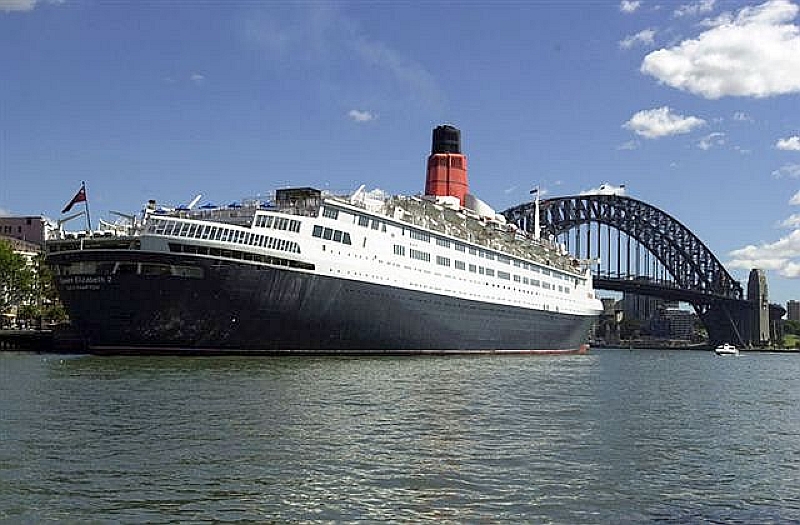
The
final version of the QE2 is seen at Sydney’s
International Passenger Terminal – Circular Quay, a great view of her aft decks!
Photo
by & © the author
Over time she
became one of the most popular cruise ships in the world, and operated her
annual around the world cruise visiting both Australia and New Zealand,
making her a regular visitor here! Amazingly it was on 5 November 2004 that the
QE2 became Cunard Lines longest
ever serving ship, as she on that day surpassed the RMS Aquitania’s record 35 years However, her days
came to an end in 2008 after she made her farewell voyages.
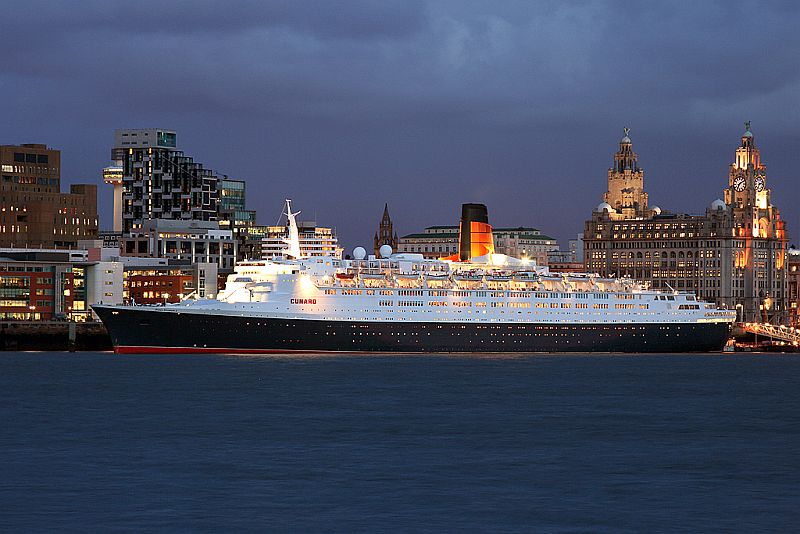
The
great Queen Elizabeth 2 photographed during her final visit to Liverpool on October 3, 2008
Photograph
by & © Alex Naughton
The QE2 left Southampton for the very last time on
November 12, 2008, with a massive fireworks presentation, escorted by a massive
flotilla of smaller craft and a there was crowd of people along the shore that
was estimated to be in the thousands. However, earlier that day, the QE2
amazingly had run aground on a sand bank whilst coming into the port, but
diving inspections revealed no damage. It was like she demonstration, “I
do not want to leave!” But she had to as the American Carnival Corp, who
owns Cunard had already been sold for a massive US$100 million, which in truth
she was not worth, although to us ship lovers, she was worth much more! She
went to Dubai, where her original plans came to nothing and she remains in
lay-up However what did sadden me was that she was registered at Port Vila,
being the capital of the small Pacific Island nation of Vanuatu, close to
Australia, but thankfully she is well maintained and looked after! But we do
not know what her future holds?
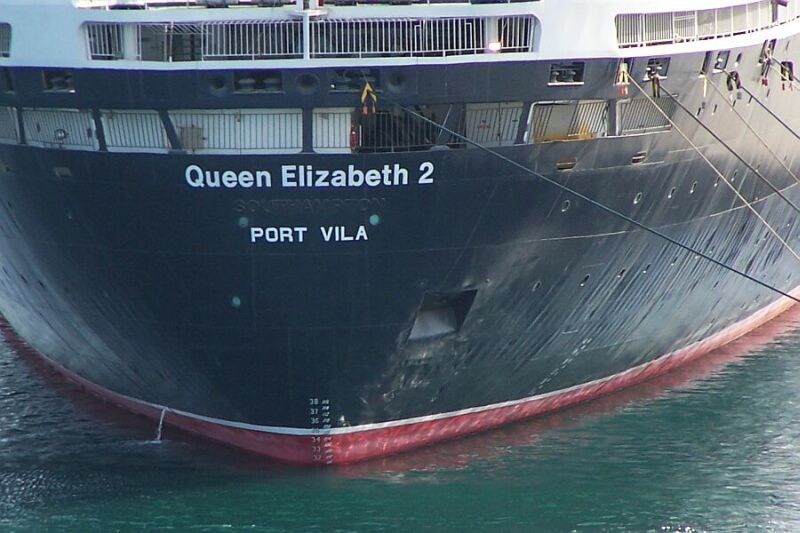
Above
& below: The author took these two photographs of the
QE2 at Dubai on September 21,
2009
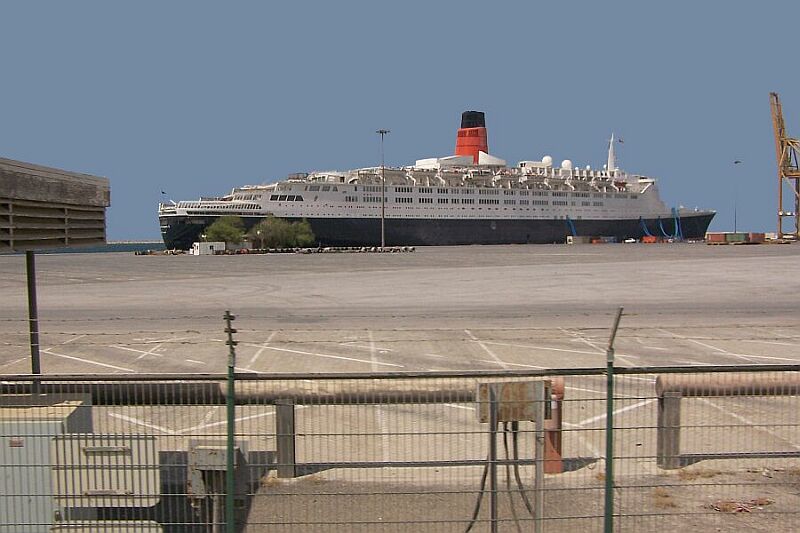
***********************************
MV Queen Elizabeth:
OK, let me be
honest from the outset, I absolutely loathe this all
American designed Vista
Class ship! Thus I cannot be more truthful that that. She departed on her
maiden voyage on October 12, 2010.
We need to understand that Cunard has always
been mostly owned by the Americans with some English ownership, but it has
always been portrayed as being ever so frightfully British!
But that has now been totally changed, for today Cunard is wholly owned by the
American Carnival Corp, that is a company that has, what
we may say has no class, or style and sadly this is a company that has just a
single mind-set. You may ask, well what is that? It is simply this: How to
extract or fleece every single Dollar or Pound out of their
passengers! That is how they have designed all their new ships and they will do
just that.
Genuine ship lovers and maritime experts will
all know that Vista Class ships are the most criticised ships in the world, and
my many friends who are respected maritime engineers and ship designers around
the world, who have built some of the finest ships, although I must say, sadly
there are dwindling, but they all say the same thing. These ships are the most
hideous vessels to hit the water and that include the RCI giants, which are
just not ships at all! Thus Cunard built that ugly and phoney Queen May 2,
which is in reality an oversized Vista Class ship that has a flat stern, but
they welded on a rounded dummy stern for looks, but her real stern can be seen
at the waterline! Then they even did the typical Disneyland thing and painted
in black looking deck forward of her superstructure, so that for afar she could
look like the old Mary with her decks forward, do they think we are all mad? It
is just black paint! Then came the MV Queen Victoria which is 100% Vista and
she was followed but the almost identical MV Queen Elizabeth, also a Vista
Class square box, or what is known in most circles as an apartment (Condo)
block!
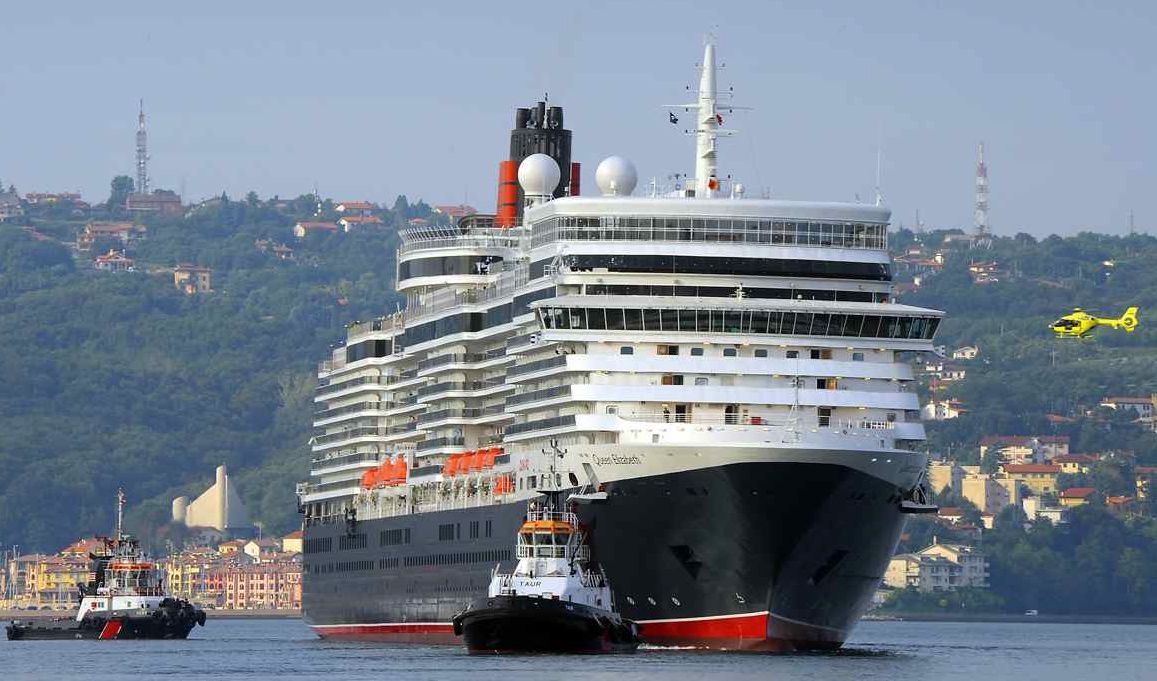
Above
& below: The hideous looking MV Queen Elizabeth, no
need to say anything else!
The
Americans certainly do no justice to the grand Dame RMS Queen Elizabeth and the
delightfully beautiful QE2
Personally,
I believe that no further ships with the name of “Queen Elizabeth” should have been built!
Certainly
not a Vista Class ship, which is like invite Her Majesty to a Classical
Concert, but have the “Sex Pistols” play Mozart!
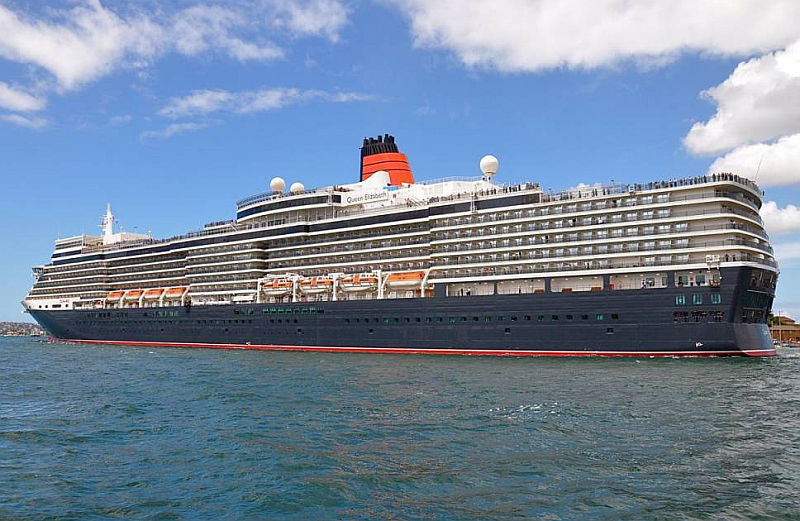
Departing
Sydney February 23,
2011
I am not saying
that their interiors ate not beautiful, for obviously they are, otherwise
passengers would not book! But, as you know Carnival is so good at adding so
many optional extras everywhere, optional dinning, optional this and that, we
will add tipping to your account every single day, thus we will take your
money. Yes, you can lower the amount if you wish, but be assured that you
steward will have a list of every passenger, and he will know just what they
have given, thus, if you think, he does not know, well guess what, they do. It
is just that the company does not tell you this, but I will! Then there are
many other features that they will push and push for you to spend on, be it the
art auctions, the Spa and every day the shops will have special’s that
are never really specials!
This non Cunard style
ship departed on her maiden voyage on October 12, 2010.
***********************************
In Conclusion:
Although we have
briefly covered the wonderful RMS and then the cruise ship MV Queen Elizabeth
2, which was without a doubt one of the last great liners
built and a fine ship, and she did the company proud! The QE2 gave many
a wonderful ocean voyages and provided them the experience of a lifetime! She
was the last Queen to be built that I will never sail on, not even if
Carnival/Cunard would give me a free deluxe suite on her, would I go for she is
a disgrace to the great company it used to be, for it was a company with class
back then. But tragically Cunard and its previous American owners completely
sold out lock stock and barrel to Carnival a company that just does not
understand what class is! Another company that sold to Carnival is Holland
America Line (HAL), however, they did something totally different to Cunard,
P&O UK and Princess ships, etc, who just sold out! HAL, although the did
sell to Carnival, but they retained their complete independence and their ships
will remain registered in Rotterdam Holland, not like the Cunard and the other
company’s, which are all being re registered in the Bahamas! HAL will
retain their Dutch staff and Indonesian and Pilipino
combination crew, which works so well! In addition, they are
not sold or marketed by Carnival, but by Holland
America
themselves as they operate their own offices and have their own marketing
teams. Now, why were they able to manage to do all that, and not Cunard?
I can tell you that very simply, the Dutch have a great deal of audacity and
great business knowledge, whereas the British, I am afraid to say, just had no
guts and very little negotiations and just let the whole thing slip through
their hands to the Americans, Thus nu guts, no glory! I am sorry, I know there
will be those who will not like what I have just said, but, at least I am
honest and I speak my mind. You can write and complain, but do not expect an
answer, for there will be none!
The great 1939 RMS Queen Elizabeth was a true and a genuine beauty, a ship with a wonderful silhouette
and a grandiose stature. Just looking at the Queen gave you that intense desire
to board her and roam her interiors, especially her wonderful lounges. She was
a true British Beauty from bow to stern!
As I have stated earlier Page Two is
dedicated to her interiors and a few other images, which I know you will enjoy!
But let me close this page by remembering this
great liner, for I am sure she is and will be remembered for all the right
reasons, be it for her brave and admirable wartime duties, or her excellent
liner services, and in her latter days as a wonderful cruise ship! She
certainly was the finest of the old stock of great ships, and I for one, and I
am sure you the reader will never forget her!
The
perfect photograph to conclude this page!
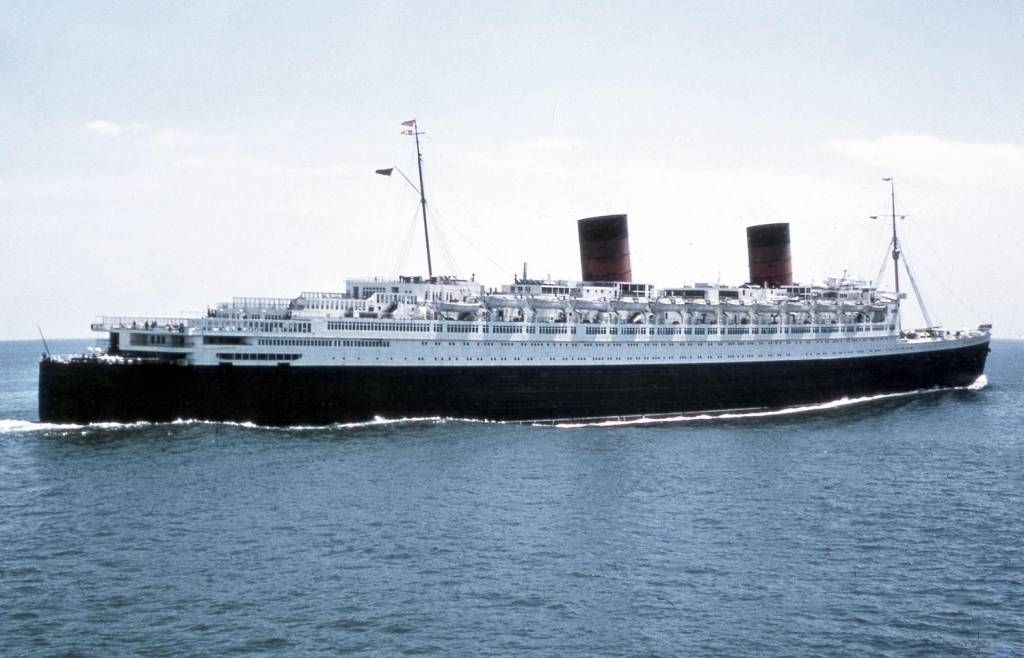
RMS
Queen Elizabeth is seen departing on another voyage; do you not wish you could
book a voyage on her today?
Farewell
Wonderful Queen, the QE2 did well to Continue the
Tradition in a Modern way
But
the R.M.S. Queen Elizabeth was Special and she will Never
be Forgotten!
INDEX:
Page One The History Page with
Images.
Page
Two Interiors
& much more!
Page
Three Advertisements
and Brochures.
“Blue Water Liners sailing to the distant shores.
I watched them come, I watched them go and I watched
them die.”
****************************
Return
to the ssMaritime
Main INDEX
Where
you will discover over 700 Classic Passenger & Passenger-Cargo Liners!
ssMaritime.com & ssMaritime.net
Where
the ships of the past make history & the 1914 built MV Doulos Story
Please
Note: ssmaritime and associated sites are 100%
non-commercial and the author seeks no funding or
favours of any shape or form, never have and never will!
Photographs on ssmaritime and associate pages are by the author or from the
author’s private collection. In addition there are some images that have
been provided by Shipping Companies and private photographers or collectors.
Credit is given to all contributors. However, there are some photographs
provided to me without details regarding the photographer/owner concerned. I
hereby invite if owners of these images would be so kind to make them-selves
known to me (my email address may be found on www.ssmaritime.com only), in order that due credit
may be given.
This
notice covers all pages, although, and I have done
my best to ensure that all photographs are duly credited and that this notice
is displaced on each page, that is, when a page is updated!
ssMaritime is owned &
© Copyright by Reuben Goossens - All Rights Reserved























































